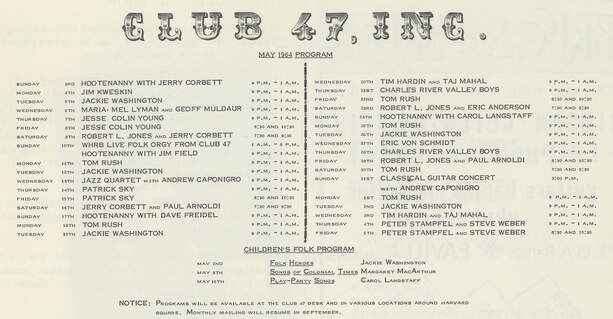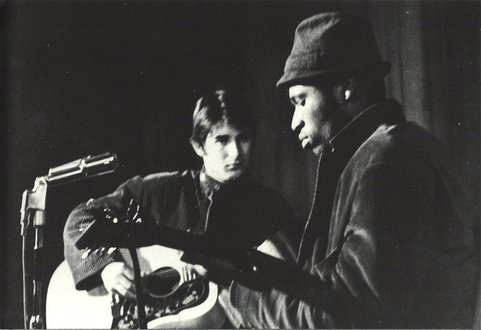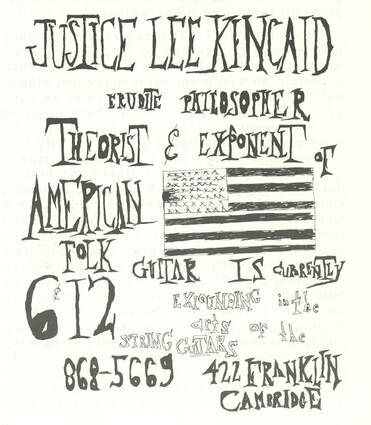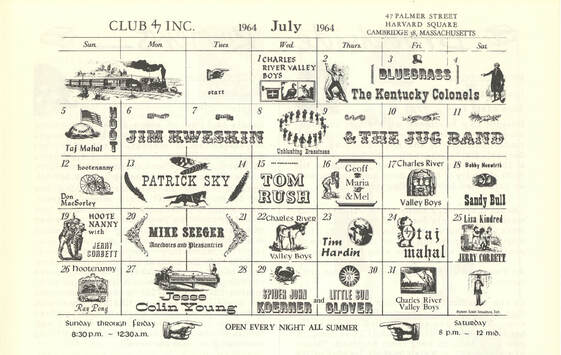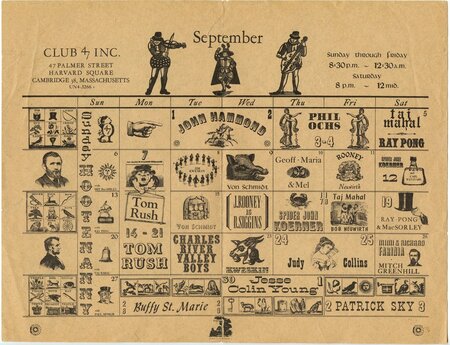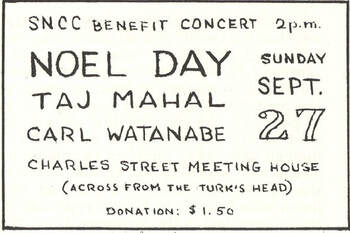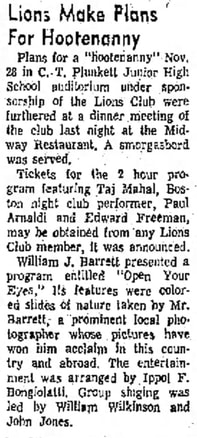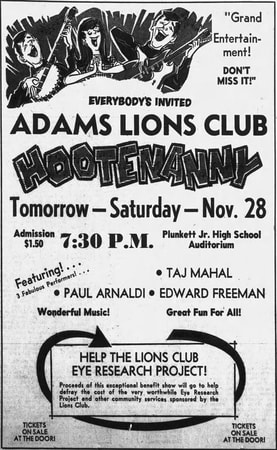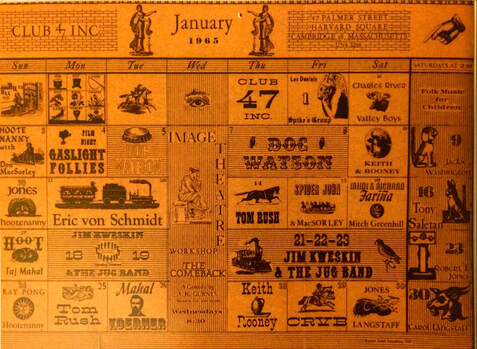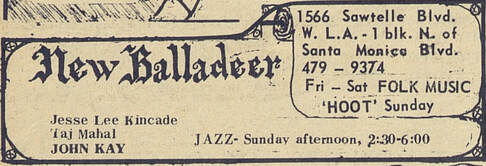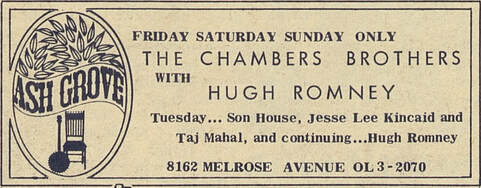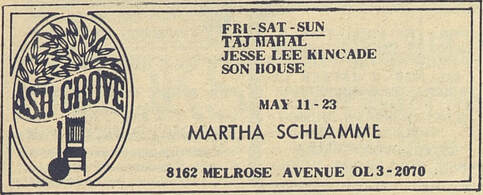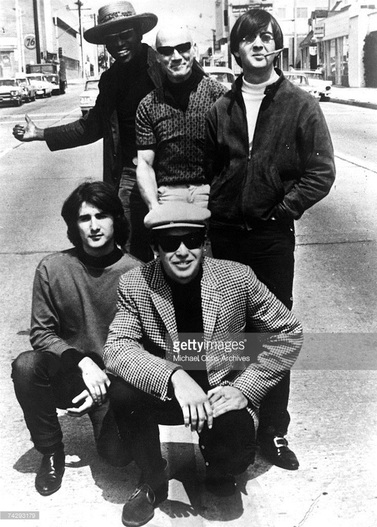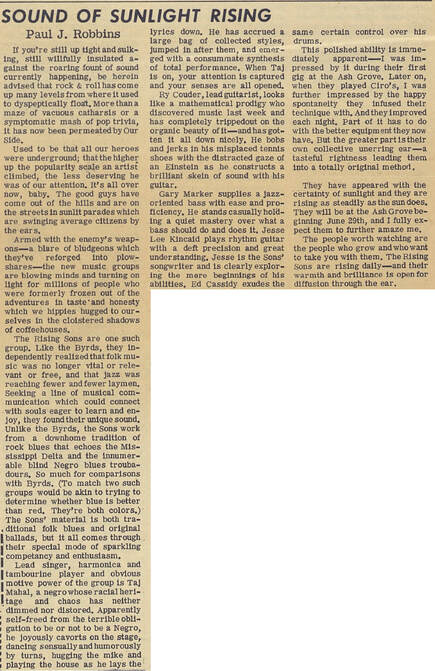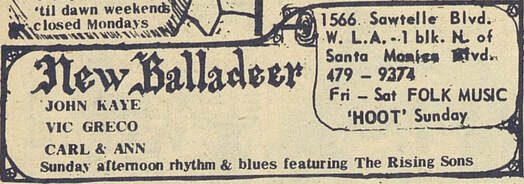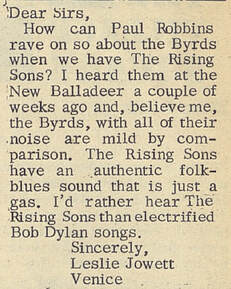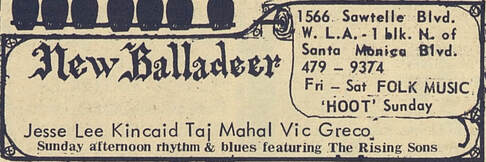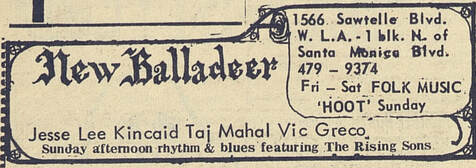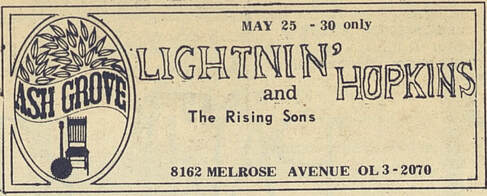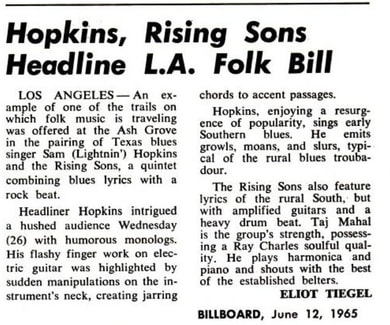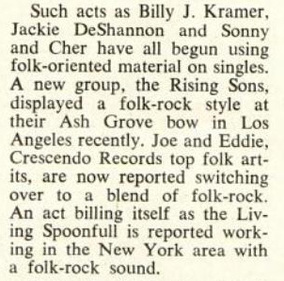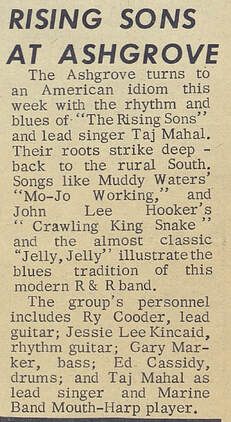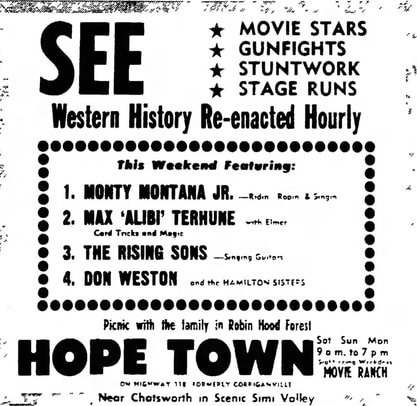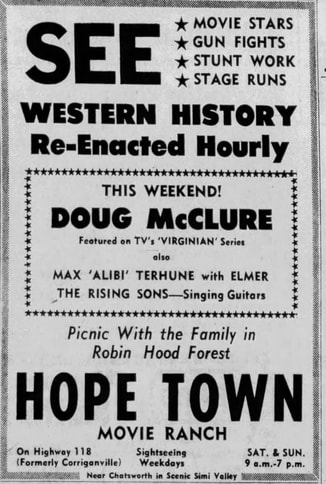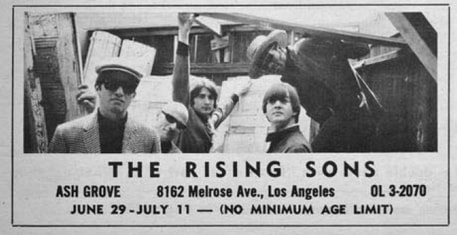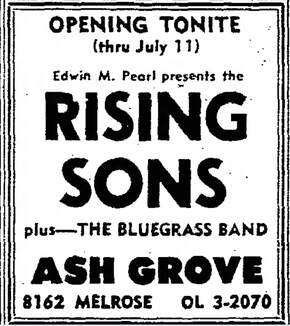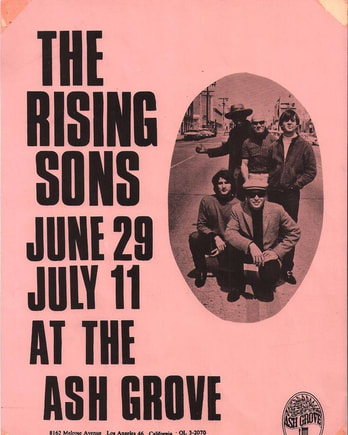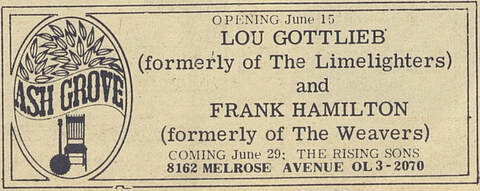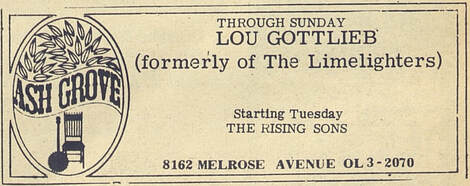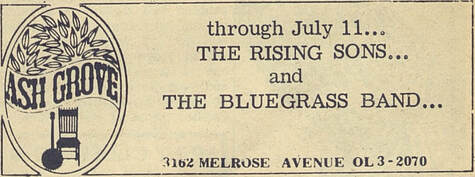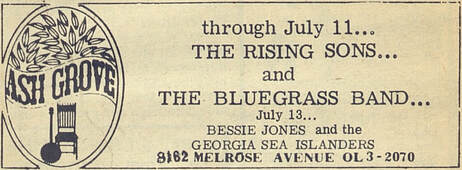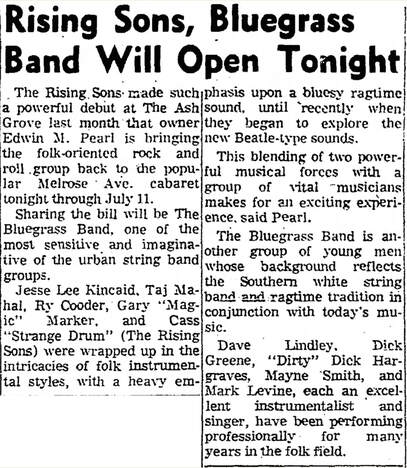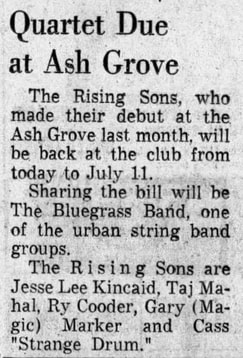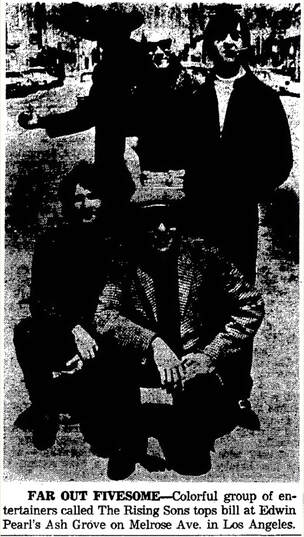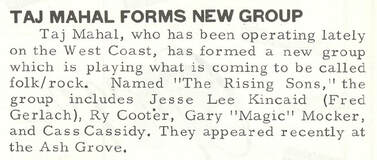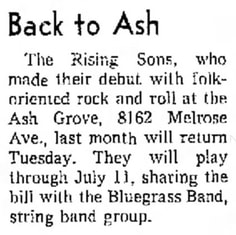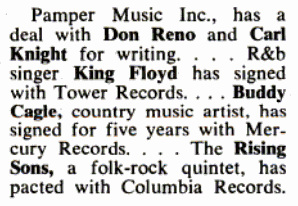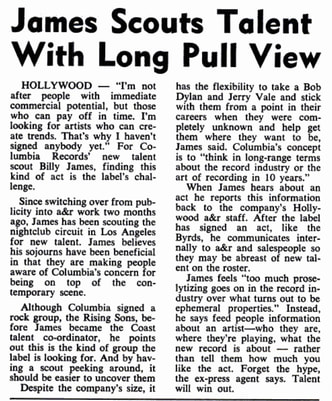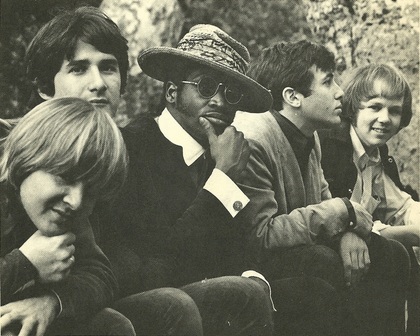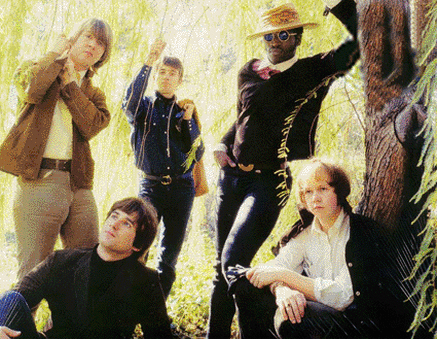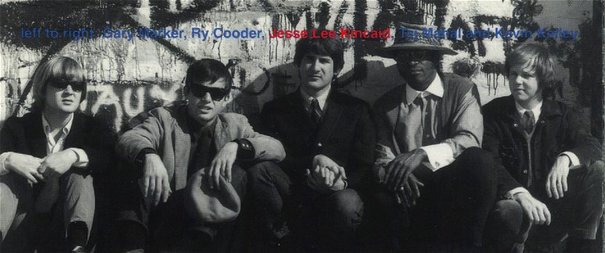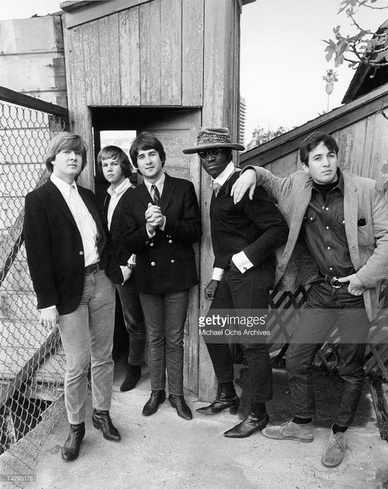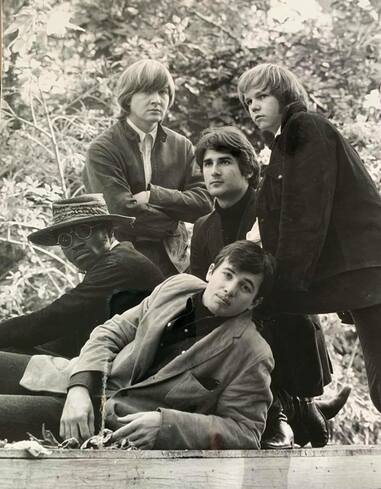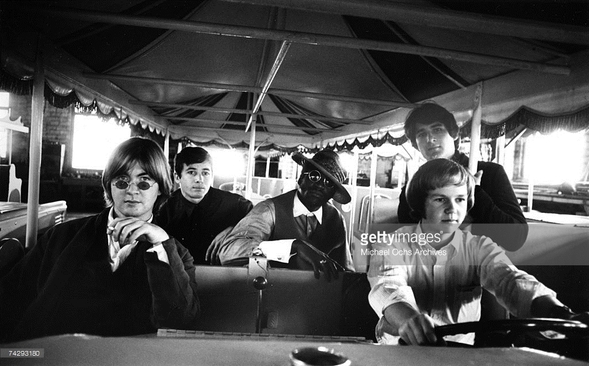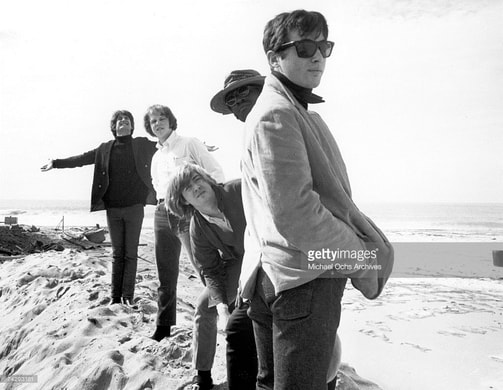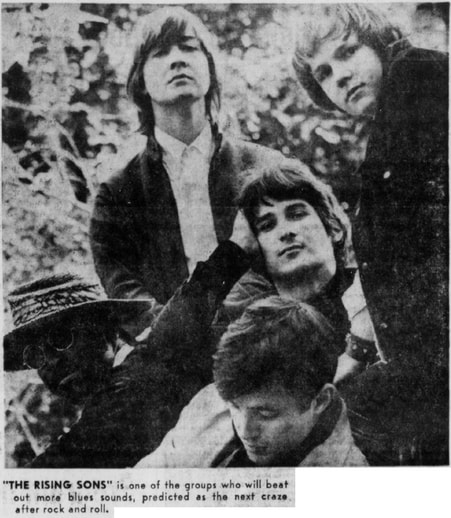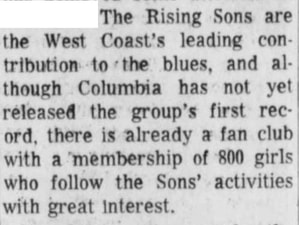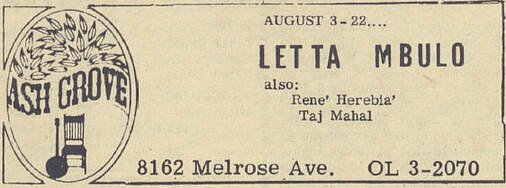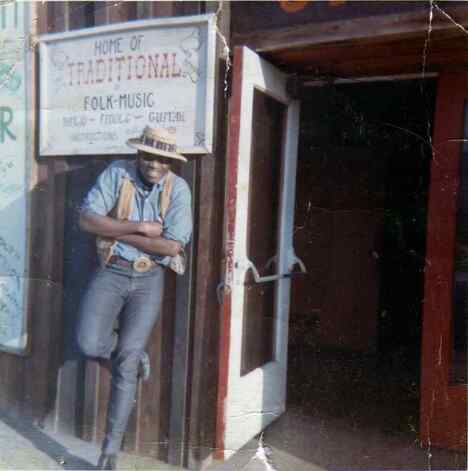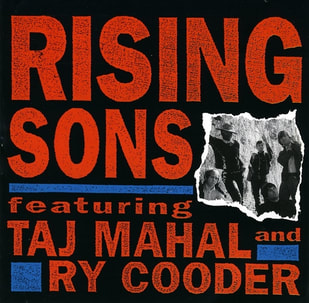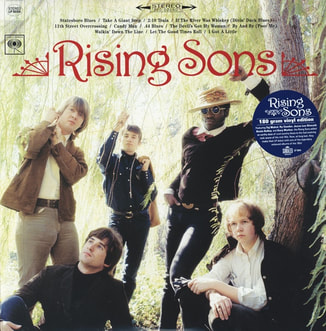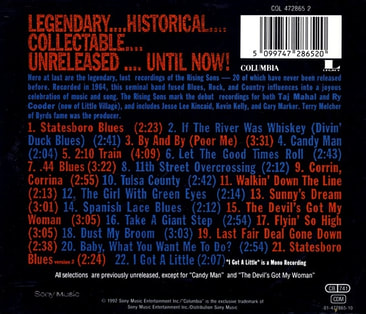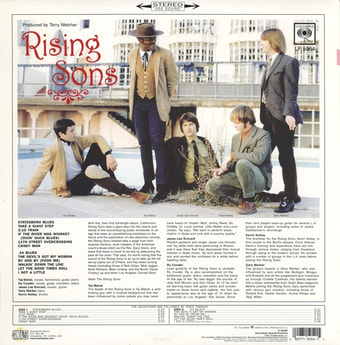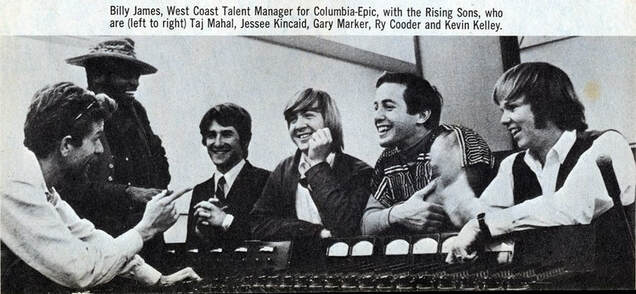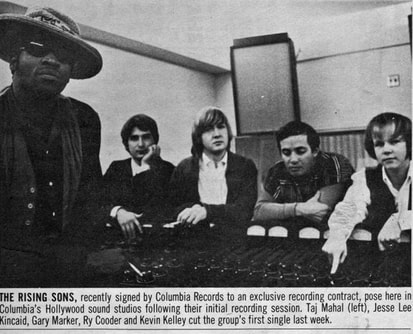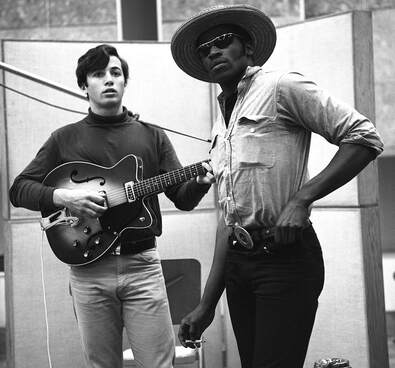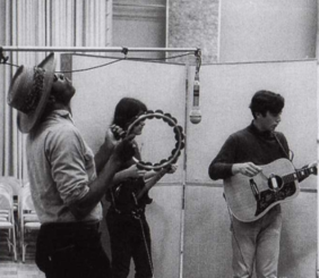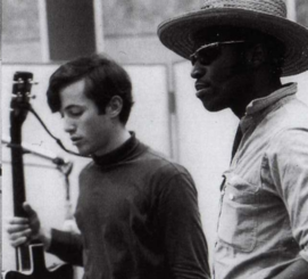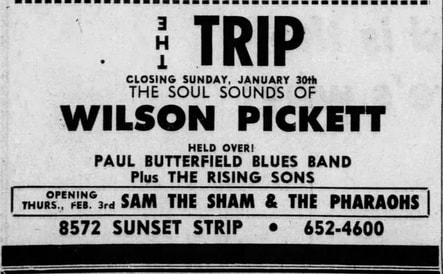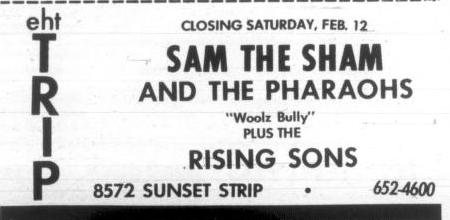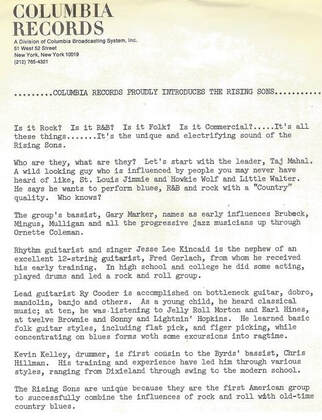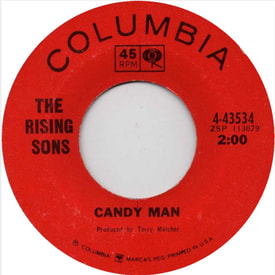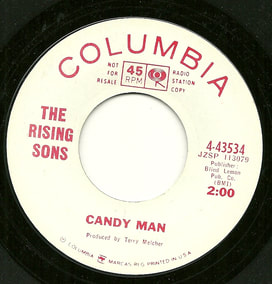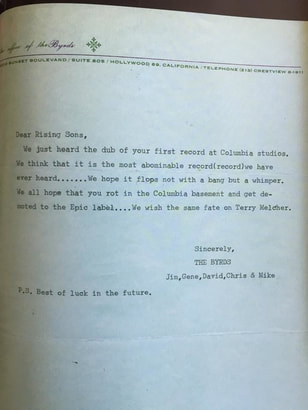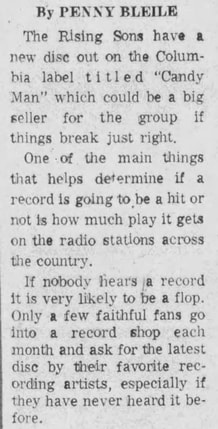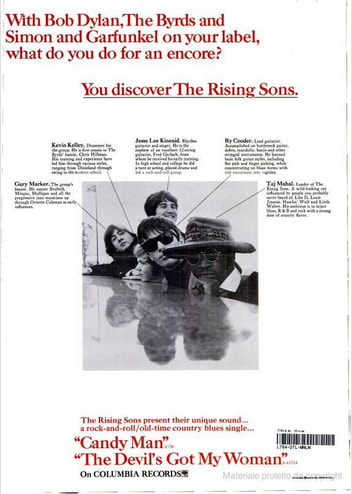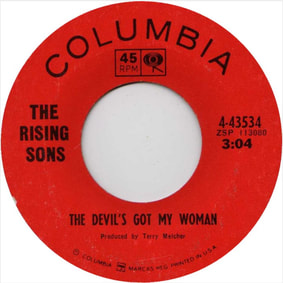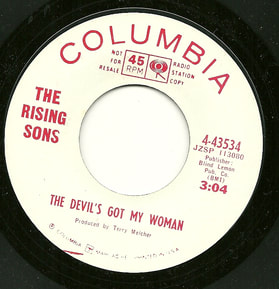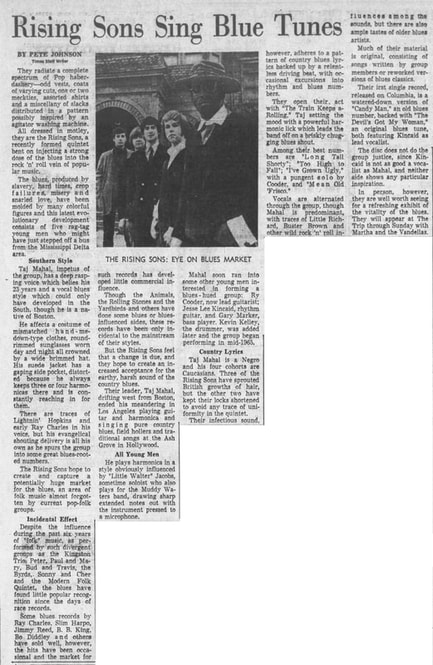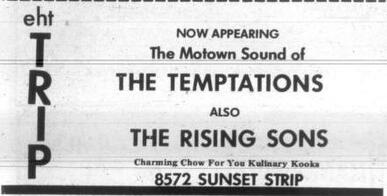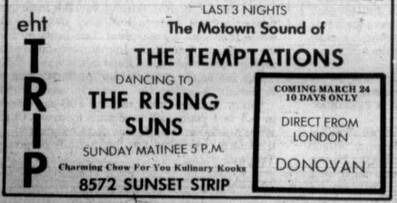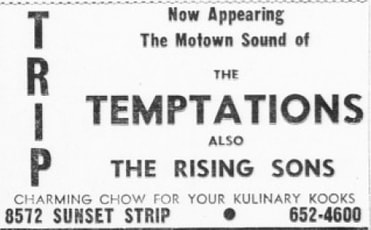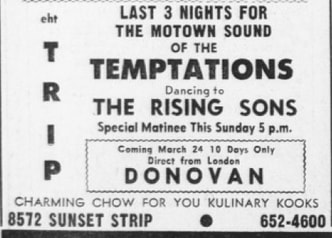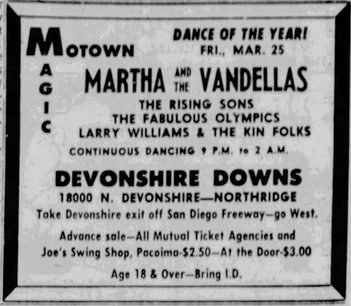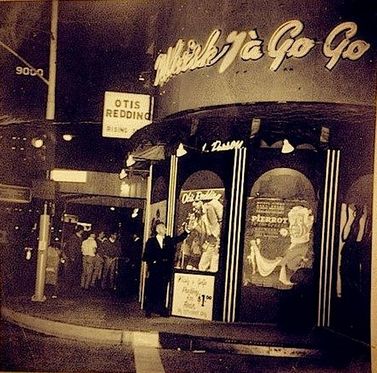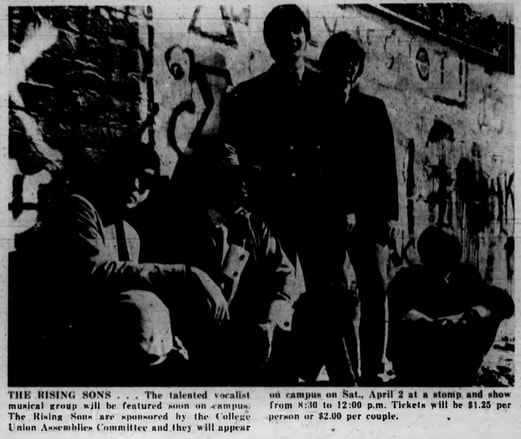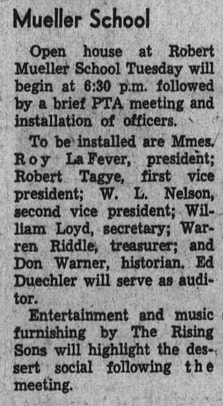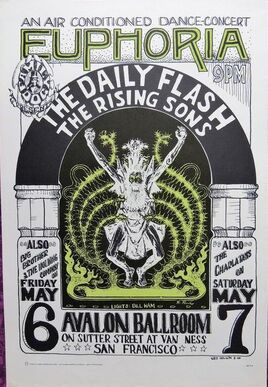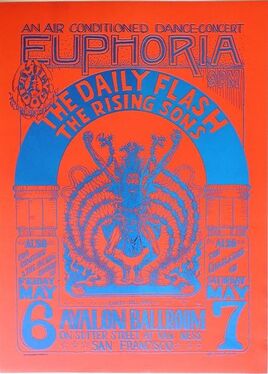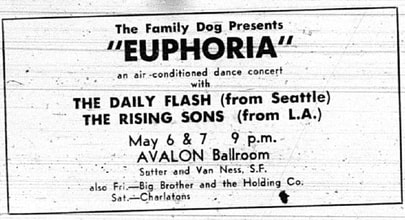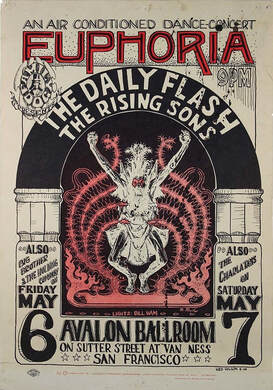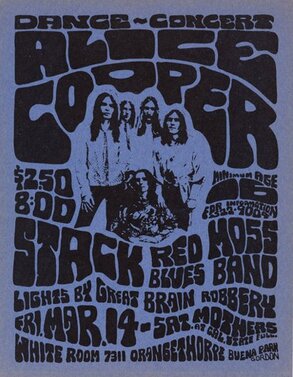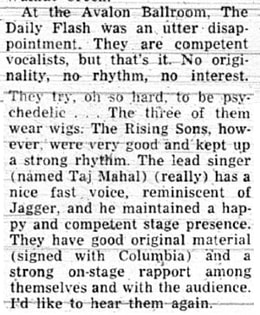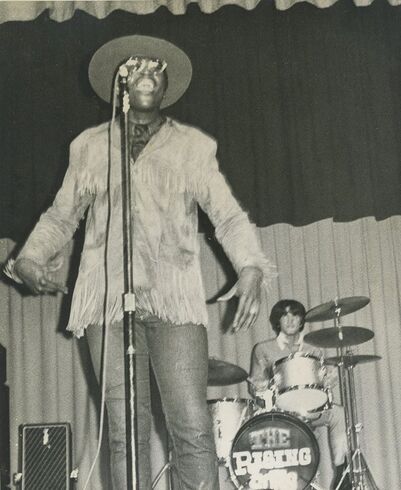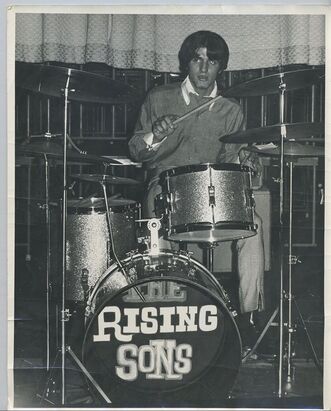If you enjoy what I have put together please consider donating any amount to support and help me to keep this valuable research going. Thanks!!
This day-by-day diary of The Rising Sons' live, studio, broadcasting and private activities is the result of three decades of research and interview work by Bruno Ceriotti, but without the significant contributions by other kindred spirits this diary would not have been possible. So, I would like to thank all the people who, in one form or another, contributed to this timeline: Jesse Lee Kincaid, Marc Kirkeby, Ed Cassidy (RIP), Taj Mahal, Johnny Rogan, John 'Drumbo' French, Gary Marker (RIP), Domenic Priore, Christopher Hjort, Ross Hannan, Corry Arnold, John H. Warburg, Bob Cuozzi, Francesco Lupica, Alan Bershaw, Gray Newell, Colin Hill, Chaim O'Brien-Blumenthal, Crystal Longdon, Paul J. Robbins, Mike Stax, Jerry Fitzgerald, Ianthe McGuinn, Aldo Pedron, Penny Bleile, Jim Salzer, Logan Janzen, Sandy Bob, Steve Martin, UCLA Daily Bruin, Detroit Free Press, The Boston Globe, The Daily Californian, Los Angeles Free Press, The Broadside, The Los Angeles Times, Chula Vista Star-News, Valley Times, The North Adams Transcript, El Mustang, Van Nuys Valley News, The Lompoc Record, Grover City Press, Van Nuys News and Valley Green Sheet, Citizen News, Long Beach Press-Telegram, Los Angeles Herald Examiner.
May 1964
Arguably the first ante litteram supergroup in the history of American rock ‘n’ roll, the Rising Sons was a Los Angeles-based short-lived multi-racial blues-rock band which found retrospective fame for launching the solo careers of singer Taj Mahal and guitarist Ry Cooder, and also for the presence in their lineup of the late drummer Ed Cassidy of Spirit fame, and of the late drummer Kevin Kelley of the Byrds fame. The man who started it all, however, was another one named Stephen Nicolas ‘Nick’ Gerlach, a Los Angeles born and raised 19-year-old aspiring folkie who was the nephew of the great late folk legend Fred Gerlach, one of the best twelve-string guitarists ever. According to his then-girlfriend Dolores DeLeon, in the fall of ’63, when she met him, Nick was attending drama and music theory classes at the local Los Angeles City College and also worked as a Kosher-deli deliveryman (later he found a new job at Will Wright’s ice cream parlor in Beverly Hills). However, Nick had been thinking about trying to make a name for himself as a musician so, after Christmas, he finally decided to drive to Cambridge, Massachusetts, since he’d gotten a gig playing twelve-string guitar at the historic Club 47 on Harvard Square, one of the first venues in a northern city to feature African American blues musicians from the South. It was there that one night, in the spring of ’64, Nick spotted a 22-year-old Afro-American up-and-coming singer named Taj Mahal. Born as Henry St. Clair Fredericks Jr. on Sunday, May 17, 1942, in Harlem, a neighborhood in the northern section of the New York City borough of Manhattan, Taj adopted his stage name when he fronted a rhythm 'n' blues party band called the Electras while attending the University of Massachusetts in Amherst in the early 1960s (he had previously sang in a doo woop group in high school). In the spring of '64, straight out from UMass, Taj moved to Cambridge with his girlfriend Maud, and the couple went to live in a room on the third floor of a three-story rental brownstone house on Putnam Avenue.
Wednesday, May 20, 1964: Club 47, 47 Palmer Street, Harvard Square, Cambridge, Middlesex County, Massachusetts
Taj Mahal solo gig. Also on the bill: Tim Hardin. One show, from 9:00pm to 1:00am. "The announcer stated, please welcome Taj Mahal," recalls his future bandmate Nick Gerlach. "A tall man walked out onto the stage clutching his blonde Epiphone guitar by the neck. He was dressed in faded Levis and a denim jacket, and sported a newsboy cap. First thing he did was take off the jacket revealing a sleeveless black t-shirt and sculpted muscles that I later learned were developed doing farm work in Massachusetts. When the jacket came off a noticeable murmur of enthusiasm emanated from the audience. He’d already caught everyone’s attention and had yet to play. I don’t remember what the songs were just that he thumped the bass strings with his bare thumb and sang old time blues songs in a voice rich with character to the delight of the crowd. Made an impression on me."
Tuesday, May 26, 1964: Turk's Head, 71 1/2 Charles Street, Beacon Hill, Boston, Suffolk County, Massachusetts
Advertised as 'Nick Gerlach 12-string guitar', the singer and guitarist performed a solo gig at The Turk's Head, Boston's oldest coffee house. "My repertoire was a combination of mostly Lead Belly songs from my uncle’s album and Reverend Gary Davis material, both consisting of complex intricate fingerpicking that made an impression on Taj [Mahal] every time he heard me play," recalls Gerlach.
Tuesday, June 9, 1964: Turk's Head, 71 1/2 Charles Street, Beacon Hill, Boston, Suffolk County, Massachusetts
Advertised as 'Nick Gerlach 12-string guitar', the singer and guitarist performed a solo gig at The Turk's Head, Boston's oldest coffee house.
Wednesday, June 3, 1964: Club 47, 47 Palmer Street, Harvard Square, Cambridge, Middlesex County, Massachusetts
Taj Mahal solo gig. Also on the bill: Tim Hardin. One show, from 9:00pm to 1:00am.
Arguably the first ante litteram supergroup in the history of American rock ‘n’ roll, the Rising Sons was a Los Angeles-based short-lived multi-racial blues-rock band which found retrospective fame for launching the solo careers of singer Taj Mahal and guitarist Ry Cooder, and also for the presence in their lineup of the late drummer Ed Cassidy of Spirit fame, and of the late drummer Kevin Kelley of the Byrds fame. The man who started it all, however, was another one named Stephen Nicolas ‘Nick’ Gerlach, a Los Angeles born and raised 19-year-old aspiring folkie who was the nephew of the great late folk legend Fred Gerlach, one of the best twelve-string guitarists ever. According to his then-girlfriend Dolores DeLeon, in the fall of ’63, when she met him, Nick was attending drama and music theory classes at the local Los Angeles City College and also worked as a Kosher-deli deliveryman (later he found a new job at Will Wright’s ice cream parlor in Beverly Hills). However, Nick had been thinking about trying to make a name for himself as a musician so, after Christmas, he finally decided to drive to Cambridge, Massachusetts, since he’d gotten a gig playing twelve-string guitar at the historic Club 47 on Harvard Square, one of the first venues in a northern city to feature African American blues musicians from the South. It was there that one night, in the spring of ’64, Nick spotted a 22-year-old Afro-American up-and-coming singer named Taj Mahal. Born as Henry St. Clair Fredericks Jr. on Sunday, May 17, 1942, in Harlem, a neighborhood in the northern section of the New York City borough of Manhattan, Taj adopted his stage name when he fronted a rhythm 'n' blues party band called the Electras while attending the University of Massachusetts in Amherst in the early 1960s (he had previously sang in a doo woop group in high school). In the spring of '64, straight out from UMass, Taj moved to Cambridge with his girlfriend Maud, and the couple went to live in a room on the third floor of a three-story rental brownstone house on Putnam Avenue.
Wednesday, May 20, 1964: Club 47, 47 Palmer Street, Harvard Square, Cambridge, Middlesex County, Massachusetts
Taj Mahal solo gig. Also on the bill: Tim Hardin. One show, from 9:00pm to 1:00am. "The announcer stated, please welcome Taj Mahal," recalls his future bandmate Nick Gerlach. "A tall man walked out onto the stage clutching his blonde Epiphone guitar by the neck. He was dressed in faded Levis and a denim jacket, and sported a newsboy cap. First thing he did was take off the jacket revealing a sleeveless black t-shirt and sculpted muscles that I later learned were developed doing farm work in Massachusetts. When the jacket came off a noticeable murmur of enthusiasm emanated from the audience. He’d already caught everyone’s attention and had yet to play. I don’t remember what the songs were just that he thumped the bass strings with his bare thumb and sang old time blues songs in a voice rich with character to the delight of the crowd. Made an impression on me."
Tuesday, May 26, 1964: Turk's Head, 71 1/2 Charles Street, Beacon Hill, Boston, Suffolk County, Massachusetts
Advertised as 'Nick Gerlach 12-string guitar', the singer and guitarist performed a solo gig at The Turk's Head, Boston's oldest coffee house. "My repertoire was a combination of mostly Lead Belly songs from my uncle’s album and Reverend Gary Davis material, both consisting of complex intricate fingerpicking that made an impression on Taj [Mahal] every time he heard me play," recalls Gerlach.
Tuesday, June 9, 1964: Turk's Head, 71 1/2 Charles Street, Beacon Hill, Boston, Suffolk County, Massachusetts
Advertised as 'Nick Gerlach 12-string guitar', the singer and guitarist performed a solo gig at The Turk's Head, Boston's oldest coffee house.
Wednesday, June 3, 1964: Club 47, 47 Palmer Street, Harvard Square, Cambridge, Middlesex County, Massachusetts
Taj Mahal solo gig. Also on the bill: Tim Hardin. One show, from 9:00pm to 1:00am.
Tuesday, June 23, 1964: Club 47, 47 Palmer Street, Harvard Square, Cambridge, Middlesex County, Massachusetts
Taj Mahal solo gig. Also on the bill: Tim Hardin.
Thursday, June 25, 1964: Turk's Head, 71 1/2 Charles Street, Beacon Hill, Boston, Suffolk County, Massachusetts
Advertised as 'Nick Gerlach 12 string guitar', the singer and guitarist performed a solo gig at The Turk's Head, Boston's oldest coffee house.
Tuesday, June 30, 1964: Club 47, 47 Palmer Street, Harvard Square, Cambridge, Middlesex County, Massachusetts
Taj Mahal solo gig. Also on the bill: Tim Hardin.
Summer 1964
When Nick Gerlach moved to Cambridge in May, he find himself renting a room upstairs an old Victorian house, at least before the summer when an acquaitance took him over to the rental house on Putnam Avenue where Taj Mahal was living. It was at that point that the two officially meet each other. "Taj pulled out a joint and fired it up," recalls Gerlach. "I sat on an old stuffed couch. Taj was ensconced in a chair facing me. We were on the second floor of our rental house on Putnam Avenue. Taj had a room on the third floor with Maud. My room was the attic." After shared the house for awhile, Taj and Nick finally rehearsed together for the first time one day there. "We took turns inhaling the aromatic weed and thus inspired we commenced to playing our acoustic guitars," continues Gerlach. "Mine was a Martin D-18 I’d found in a Los Angeles music store. It had been covered in layers of red, blue, yellow, gold paint which I’d stripped off to reveal the natural mahogany and spruce wood that Martin started with. Taj played a blonde maple Epiphone. We were improvising around blues changes in the key of C. Taj sang lyrics from some ancient Mississippi songs describing flooding of levees, mules plowing, and going up to the country in the delta. There was some unique bounce in our improvising that had to do with a double time finger picking pattern I was doing over Taj’s four to the floor beat that was compelling. We laughed about it and delved further into the idea. We christened the concept Delto, twisting the word into a mispronunciation synonymous with regional dialects in the south. Taj inquired, 'I have a show beginning tomorrow for two weeks at The 2nd Fret in Philadelphia. Do you want to come and do it with me?'." By the way, it was at that point that Nick Gerlach adopted the nom de folk of Jesse Lee Kincaid.
TAJ MAHAL & JESSE LEE KINCAID (SUMMER 1964 - MAY 1965)
1) Taj Mahal vocals, acoustic guitar, harmonica
2) Jesse Lee Kincaid vocals, acoustic guitar
1) Taj Mahal vocals, acoustic guitar, harmonica
2) Jesse Lee Kincaid vocals, acoustic guitar
Summer 1964: The 2nd Fret, 1902 Folsom Street, Rittenhouse Square, Philadelphia, Pennsylvania
"On our first class jet flight from Boston to Philadelphia the spacious seating gave me a taste of luxury a bit beyond the standard and a glimpse of the lofty possibilities performance might provide," recalls Jesse Lee Kincaid. "The 2nd Fret was our first professional engagement together," he adds. "We began by each doing individual sets then played and sang together, developing material as we progressed. In addition to singing and accompanying the song with his standard tuned Epiphone guitar, Taj used my Martin D-18 in open G and D tunings to play bottleneck slide guitar in the style of Robert Johnson. Taj utilized a rack to play harmonica while playing guitar. His lyrics were drawn from the canon of earlier blues songs that described low down cheating women, Mississippi River levee breaks, gambling on horses, and waking up this morning with the blues. Having been an avid listener of KGFJ radio in Los Angeles, a rhythm and blues station, I was familiar with the two part harmony singing style of Don and Dewey and utilized that for us to sing together on songs like 'Corrina, Corrina'." "[By then] our music consisted of songs sung by one or the other of us while we traded off using our two acoustic guitars, my Martin D-18 and Taj’s blonde Epiphone," he continues. "Taj liked the Martin’s flat fingerboard for open tuned slide playing since the Epiphone had a curved fingerboard less functional for the slide. Our strings were supplemented by Taj’s harmonica playing. Taj had already been performing regularly, booked by Manny Greenhill at Folklore Productions. He had a repertoire of blues material with lyrics drawn from the work of previous blues singers from an earlier era, singers like Leadbelly, Robert Johnson, and Mississippi John Hurt. I adapted to these styles, adding second guitar and harmony on songs like 'Corrina, Corrina' and 'Baby, What You Want Me To Do,' or letting Taj take the vocal alone. We had developed a thigh slapping rhythm on 'Hambone' that never failed to amuse audiences and Taj did Leadbelly’s 'Linin’ Track,' unaccompanied as a solo vocal."
Sunday, July 5, 1964: 'Hoot', Club 47, 47 Palmer Street, Harvard Square, Cambridge, Middlesex County, Massachusetts
Taj Mahal solo gig.
Friday, July 24, 1964: Club 47, 47 Palmer Street, Harvard Square, Cambridge, Middlesex County, Massachusetts
Taj Mahal solo gig.
Friday, August 14, 1964: Club 47, 47 Palmer Street, Harvard Square, Cambridge, Middlesex County, Massachusetts
Taj Mahal solo gig.
Sunday, August 23, 1964: 'Hoot', Club 47, 47 Palmer Street, Harvard Square, Cambridge, Middlesex County, Massachusetts
Taj Mahal solo gig.
Wednesday, August 26, 1964: Club 47, 47 Palmer Street, Harvard Square, Cambridge, Middlesex County, Massachusetts
Advertised as Taj Mahal & Soul Inc.
Saturday, September 5, 1964: Club 47, 47 Palmer Street, Harvard Square, Cambridge, Middlesex County, Massachusetts
Taj Mahal solo gig. Also on the bill: Ray Pong.
Friday, September 18, 1964: Club 47, 47 Palmer Street, Harvard Square, Cambridge, Middlesex County, Massachusetts
Taj Mahal solo gig. Also on the bill: Bob Neuwirth.
Sunday, September 20, 1964: 'Hoot', Club 47, 47 Palmer Street, Harvard Square, Cambridge, Middlesex County, Massachusetts
Taj Mahal solo gig.
Sunday, September 27, 1964: 'SNCC (Student Nonviolent Coordinating Committee) Benefit Concert', Charles Street Meeting House, 70 Charles Street, Beacon Hill, Boston, Suffolk County, Massachusetts
Taj Mahal solo gig. Also on the bill: Noel Day, Carl Watanabe. One show, started at 2:00pm.
Monday, September 28, 1964: Turk's Head, 71 1/2 Charles Street, Beacon Hill, Boston, Suffolk County, Massachusetts
Taj Mahal solo gig.
Fall 1964: The Fifth Amendment, Bleury Street, just north of Saint Catherine Street, Downtown Montreal, Quebec, Canada
Taj Mahal & Jesse Lee Kincaid's gig. "Having now formed a template of sorts during our two week stint at the Fret we went on to do a series of engagements during the autumn of 1964, all booked by Folklore," recalls Kincaid. "Our next gig was scheduled at The Fifth Amendment, a folk club in Montreal, Canada, another two week engagement." "In a window of a Montreal cobbler we saw a collection of shoes made to order and we were taken by a style of sheepskin lined suede outer calf high boots," he continues. "With further inquiry we both ordered a pair that would be ready before our departure. These golden suede boots worn with the pants tucked in became our trademark fashion statement and garnered no little attention in performances."
Monday, October 5, 1964: Turk's Head, 71 1/2 Charles Street, Beacon Hill, Boston, Suffolk County, Massachusetts
Taj Mahal solo gig.
Friday, October 9 - Saturday, October 10, 1964: Saladin Coffee House, 414 North Pleasant Street, Amherst, Hampshire County, Massachusetts
Taj Mahal solo gigs.
Saturday, October 10, 1964: 'Cambridge Weekend For Mississippi Freedom - SNCC (Student Nonviolent Coordinating Committee) Benefit Concert', Auditorium, Rindge Technical School, Cambridge Street, Cambridge, Middlesex County, Massachusetts
Taj Mahal solo gig. Also on the bill: Tom Rush, John Hammond Jr., Ray Pong. One show, started at 8:00pm.
Monday, October 12, 1964: Turk's Head, 71 1/2 Charles Street, Beacon Hill, Boston, Suffolk County, Massachusetts
Taj Mahal solo gig.
Tuesday, October 13, 1964: 'Balladeers', WHRB (95.3MHz), Cambridge, Middlesex County, Massachusetts
From 7:15pm to 8:00pm, Taj Mahal performed live on the air at Balladeers, a folk music radio show hosted by famous folksinger Tom Rush every Tuesday on WHRB, Harvard's radio station.
Wednesday, October 14, 1964: Club 47, 47 Palmer Street, Harvard Square, Cambridge, Middlesex County, Massachusetts
Taj Mahal solo gig. Also on the bill: Amy Boutte & Jerry Edwards.
Sunday, October 18, 1964: 'Hoot', Club 47, 47 Palmer Street, Harvard Square, Cambridge, Middlesex County, Massachusetts
Taj Mahal solo gig.
Tuesday, October 27, 1964: Club 47, 47 Palmer Street, Harvard Square, Cambridge, Middlesex County, Massachusetts
Taj Mahal solo gig. Also on the bill: Eric Andersen.
Friday, November 6, 1964: 'Folk City USA', WCRB (1330 AM, 102.5 FM), Brighton, Boston, Suffolk County, Massachusetts
Taj Mahal performed live on the air at Folk City USA, a radio show hosted and produced by the late Robert J. 'Bob' Lurtsema, and broadcasted in stereo on local radio station WCRB every Friday from 11:15pm to 1:00am. Also appeared: Jerry Corbitt, Nancy Michaels, Johnny O'Dea, Dusty Rhodes.
Sunday, November 8, 1964: Turk's Head, 71 1/2 Charles Street, Beacon Hill, Boston, Suffolk County, Massachusetts
Taj Mahal solo afternoon gig.
Sunday, November 8, 1964: 'Hoot', Club 47, 47 Palmer Street, Harvard Square, Cambridge, Middlesex County, Massachusetts
Taj Mahal solo evening gig.
Friday, November 20, 1964: Club 47, 47 Palmer Street, Harvard Square, Cambridge, Middlesex County, Massachusetts
Taj Mahal solo gig. Also on the bill: Mimi & Dick Farina.
Saturday, November 28, 1964: 'Adams Lions Club Hootenanny', Auditorium, C.T. Plunkett Junior High School, 14 Commercial Street, Adams, Berkshire County, Massachusetts
The show, which started at 7:30pm, was a benefit where all the proceeds were earmarked for the local Lions Club's charity projects. Taj Mahal, along with Paul Arnoldi, and Edward Freeman, was billed as a solo performer, but according to Jesse Lee Kincaid he was there to play with him too. Also according to Kincaid, although unbilled, his old friend, mentor, and guitar teacher, the great late Reverend Gary Davis, also performed. "Arriving at a Boston [sic] auditorium for a folk music show we found Reverend Gary Davis backstage holding forth picking guitar with a semi circle of enthusiastic young guitarists playing along as best they could while learning the patterns," recalls Jesse Lee Kincaid. "Recognizing the song as one we had played together back in Los Angeles I quickly removed my guitar from its case and joined in. Being blind Gary did not see me but hearing me play he raised his head and inquired, 'Jesse, is that you?' He recognized me by my sound." "The iconic record producer John Hammond who signed Bob Dylan, Benny Goodman, Billie Holiday, and Bruce Springsteen, among many unforgettable others to Columbia Records, came to hear us," he adds. "The next day John came to our house and listened while we ran through some of our 'Delto' material. John said he liked our sound but wasn’t ready to sign us yet. Some small seed must have been planted then because when we later became a band we did sign with Columbia and when Taj went solo it was with Columbia."
Friday, December 4, 1964: Club 47, 47 Palmer Street, Harvard Square, Cambridge, Middlesex County, Massachusetts
Taj Mahal solo gig. Also on the bill: Don MacSorley.
Thursday, December 10, 1964: Club 47, 47 Palmer Street, Harvard Square, Cambridge, Middlesex County, Massachusetts
Taj Mahal solo gig. Also on the bill: Hamsa El Din.
Friday, December 11 - Saturday, December 12, 1964: King's Rook, 4th South Main Street, Ipswich, Essex County, Massachusetts
Taj Mahal solo gigs.
Saturday, December 12, 1964: 'Children Concert Series', Club 47, 47 Palmer Street, Harvard Square, Cambridge, Middlesex County, Massachusetts
A series of special programs for children was presented at Club 47 each Saturday afternoon during that month. On December 12, Taj Mahal performed a special program of "Negro Children's Songs". Nedless to say, no adult was allowed to enter unless accompanied by a child!
Saturday, December 19, 1964: 'SNCC Concert', Turk's Head, 71 1/2 Charles Street, Beacon Hill, Boston, Suffolk County, Massachusetts
Taj Mahal solo afternoon gig.
Monday, December 21, 1964: Club 47, 47 Palmer Street, Harvard Square, Cambridge, Middlesex County, Massachusetts
Taj Mahal solo gig.
Tuesday, December 22 - Wednesday, December 23, 1964: Turk's Head, 71 1/2 Charles Street, Beacon Hill, Boston, Suffolk County, Massachusetts
Taj Mahal and Jesse Lee Kincaid's gigs.
Tuesday, December 29, 1964: Foxborough Jr. High School, 111 Mechanic Street, Foxborough, Norfolk County, Massachusetts
Taj Mahal solo gig. Also on the bill: Walt Bjorkman, Anne Tansey. One show, started at 8:00pm.
Sunday, January 17, 1965: 'Hoot', Club 47, 47 Palmer Street, Harvard Square, Cambridge, Middlesex County, Massachusetts
Taj Mahal solo gig.
Tuesday, January 26, 1965: Club 47, 47 Palmer Street, Harvard Square, Cambridge, Middlesex County, Massachusetts
Taj Mahal solo gig. Also on the bill: Spider Joe Koerner.
Tuesday, February 2, 1965: Turk's Head, 71 1/2 Charles Street, Beacon Hill, Boston, Suffolk County, Massachusetts
Taj Mahal and Jesse Lee Kincaid's gig.
February ? - 1?, 1965: The Chess Mate, 17126 Livernois Road at 6 Mile Road, Detroit, Wayne County, Michigan
"Autumn turned to winter as the east coast chill brought snow and biting wind," recalls Jesse Lee Kincaid. "Taj and I had become a working duo. In consideration of how to proceed we thought about moving it over to Europe or making it to Los Angeles. The folk wave was by this time giving way to The Beatles and The Rolling Stones. Folk purists who up to now had emulated the rural backwoods music style of yesteryear began to find the attraction to modern rock and rolling with amplifiers and drums too compelling to ignore and were plugging in and combing their hair forward. Bob Dylan was about to unleash an electric tidal wave at the Newport Folk Festival that would signal the dawning of a new pop music era and say adios to the purist folk movement as a major cultural force. California beckoned as a possible fertile ground for us to explore. We lost our rental house and conveniently were footloose when we traveled to Detroit, Michigan, for a two week gig at the Chess Mate. Our accommodation consisted of 2 skinny beds along the wall in the club’s kitchen. Easy commute from bed to the stage. We’d made up our mind to go on to Los Angeles at gig’s end and the dark cold chill of Detroit just put an exclamation mark on the concept. I so remember walking in the zero degree snowstorm, wind pushing me back the whole time. My guitar cracked in its case from the cold."
February ??, 1965
"Taj and I acquired a driveaway Cadillac from a delivery agency and left Detroit and the east coast in search of greener and definitely warmer pastures in Hollywood, California," recalls Jesse Lee Kincaid. "And you know what happens when they leave the farm. They never come back. We were heading straight into the Great Wide Open and the trippy Sunset Strip in the land of movie stars, shady bars, and shiny cars. Nothing would ever be the same. We’ve looked at the events, the outside, the coming together of two men who find mutual interest in music. But what was the music. What was Taj? What was Jesse? Where did we begin and what tools were we using? That’s the inside. And where was it going?" "Taj and I traveled west on Route 66 on an inner journey to learn about music that has yet not ceased," he adds. "We would not travel always together but at this moment our futures were intertwined as the golden shore beckoned. Attired in our folksinger jeans, work shirts, and conspicuous golden matching boots a big black guy and a white guy we tooled across the green plains of the United States in a new Cadillac, cautiously selecting restaurants in the midwest that might not react to us in some racist bigoted manner and we largely succeeded, pulling in my dad’s house to the Silver Lake district of Los Angeles. Introductions were made, the tool shed out back was assigned to us for our quarters, we hit the rack for the night, and in the morning we went about reaching for the golden ring of stardom."
April ?, 1965
Back home in Los Angeles, Jesse Lee Kincaid soon reconnected with his old friend and guitar teacher Ry Cooder. "Ry had been a guitar student of my uncle Fred Gerlach and had briefly been a guitar teacher of mine but after a few lessons he refused to teach me any more saying I was learning all his tricks," recalls Kincaid. "Ry was a guitar prodigy at age 4 and by age 16 he recorded and toured with Jackie DeShannon. He was often spoken about in music circles with an air of reverential awe." Undoubtedly one of the greatest guitarist of all time, Ryland Peter Cooder was born on Saturday, March 15, 1947, in Santa Monica, Los Angeles County. Between 1963 and 1965, Ry played with the likes of Jackie DeShannon, David Cohen, Pamela Polland, the Jazz Folk (with Gary Marker), the Gramercy Park Sheiks (with Steve Katz and Stefan Grossman), and Bill Monroe and His Bluegrass Boys, as well as solo performer. "Martin guitars, through Santa Monica's McCabe's Guitar Shop, was sponsoring Ry to demostrate their guitars in a booth at the annual Teen-Age Fair at the Hollywood Palladium," continues Kincaid. "Ry reasoned we [he, Jesse, and Taj] could play the gig, coming up in one week, if we added his childhood friend Gary Marker, primarily a jazz bassist who had attended Boston’s Berklee School of Music on a scholarship from Downbeat magazine, a jazz publication." Born as Gary Alfred Marker on Tuesday, May 24, 1943, in Santa Monica, he had played since the late 1950s with a lot of groups such as the New Jazz Trio, the New World Jazz Company, the Gary Market Quartet, and the Jazz Folk. "Since the event was to include amplifiers I decided to borrow my friend Freddie the Freeloader’s drum set and play the gig as a drummer, relying on my junior high school band experience as a drummer," concludes Kincaid. "Freddie delivered his sparkling silver Ludwig kit to the Palladium just before showtime, Taj and Ry played electric guitars, Gary played bass and I played drums. We were a band."
UNNAMED LIVE BAND (APRIL 9 - APRIL 16, 1965)
1) Ry Cooder lead guitar
2) Taj Mahal vocals, rhythm guitar, harmonica
3) Gary Marker bass
4) Jesse Lee Kincaid drums
Friday, April 9 - Friday, April 16, 1965: '4th Annual Teen-Age Fair', Hollywood Palladium, 6215 Sunset Boulevard, downtown Hollywood, Los Angeles County, California
The as yet unnamed band debuted live at the '4th Annual Teen-Age Fair' that was held for eight days in and on the grounds of the Hollywood Palladium, which was basically a dance hall with a big parking lot down on the infamous Sunset Strip. There were bands playing inside and bands playing outside in booths and tens that had been set up. There was also a 'battle of the bands' competition for bands who were not yet signed to labels. The Teen Fair concept was to focus on the demographics of teenagers and find out what kind of merchandising would best appeal to these post-British Invasion adolescents. As mentioned above, Ry Cooder and company were assigned to demonstrate Martin electric guitars (and apparently also Vega banjos) at the McCabe's Guitar Shop booth, which was located inside on the west balcony. "I remember that we were inside," confirms Gary Marker on John 'Drumbo' French's book Beefheart: Through The Eyes of Magic (2010). "What had happened was that it ended up so many people clogged around, because you know, we were pretty unusual, an integrated group playing this funky crap in there, instead of surf stuff, that finally the Fire Department came in and said, 'You gotta get all these people out of the aisle.' The guys in the booth said, 'We can't, that's what they're here for!' So they moved us outside, they gave us a bigger booth on the midway. So, outside we went, where there was more room for people to wander around. You know, we still kept getting crowds. [We were just a] bunch of guys just sitting around jamming. We thought, 'Hmm, if we can attract people here, maybe we can do it better.' They seemed to like this music. It was a lot of Jimmy Reed stuff, you know, and then we'd throw in Howlin' Wolf stuff." Curiously, on Thursday, April 15, another local band, a surf combo called the Maltesemen, was assigned to demonstrate Fender electric guitars and amplifiers at the Fender Music booth, which was located right next to McCabe's Guitar Shop booth. "We were assigned an inside booth and whoever did the scheduling must have been nuts because they assigned another band to the booth right next to us in the same time slot," recalls the Maltesemen drummer John 'Drumbo' French in his book Beefheart: Through The Eyes of Magic (2010). "There was a black guy singing and playing guitar, everyone else was white. Two were sitting and two were standing. The drummer was playing this weird rhythm that accented the 3rd, 6th, and 8th beat on the hi-hat and snare. The kick was 1st, 4th, 5th, and 7th. It was completely foreign thing to me. The black guy played rhythm guitar and a harmonica, which was held on a holder around his neck, Bob Dylan-style. I had never heard music like this and didn't really pay much attention. I was excited and scared about playing 'in Hollywood' and wasn't really concerned with anything except the fact that these guys were next to us and both of us were trying to play loud music. It was a difficult situation. We had a little discussion with them and diplomatically agreed to take turns playing for the people. We took turns of about 20 minutes, them playing first, then us for the two hours or so we were both scheduled to play. I later discovered that this black guy was Taj Mahal, the band was the Rising Sons [sic] and the lead guitarist was a young guy named Ry Cooder. What a contrast it was to be exchanging songs with them in this performance situation - surf music and Delta blues. Us in our shiny blue matching suits with toreador jackets and they, dressed more like the early Rolling Stones." [Oh, by the way, John 'Drumbo' French will play with Ry Cooder and Gary Marker in Captain Beefheart and His Magic Band a couple of years later, but that's another story].
Friday, April 16 - Sunday, April 18, 1965: 'Folk Music (Fri-Sat) and Hoot (Sun)', New Balladeer, 1566 Sawtelle Boulevard, 1 block north of Santa Monica Boulevard, West Los Angeles, Los Angeles County, California
Taj Mahal and Jesse Lee Kincaid opened for the latter's uncle Fred Gerlach. "I listed possible venues at the folk clubs I knew about and at first opportunity, booted and suited we set forth to the New Balladeer," recalls Jesse Lee Kincaid. "Present that night in the audience was singer Jackie DeShannon and John Kay, future singer for Steppenwolf who at the time was the club dishwasher. We had a pretty good repertoire developed over the last 6 months of constant performance that included a presentation of 'Hambone' in which we sat singing and did our rhythmic body slapping routine that always amused audiences. Suffice to say that we were well received."
The as yet unnamed band debuted live at the '4th Annual Teen-Age Fair' that was held for eight days in and on the grounds of the Hollywood Palladium, which was basically a dance hall with a big parking lot down on the infamous Sunset Strip. There were bands playing inside and bands playing outside in booths and tens that had been set up. There was also a 'battle of the bands' competition for bands who were not yet signed to labels. The Teen Fair concept was to focus on the demographics of teenagers and find out what kind of merchandising would best appeal to these post-British Invasion adolescents. As mentioned above, Ry Cooder and company were assigned to demonstrate Martin electric guitars (and apparently also Vega banjos) at the McCabe's Guitar Shop booth, which was located inside on the west balcony. "I remember that we were inside," confirms Gary Marker on John 'Drumbo' French's book Beefheart: Through The Eyes of Magic (2010). "What had happened was that it ended up so many people clogged around, because you know, we were pretty unusual, an integrated group playing this funky crap in there, instead of surf stuff, that finally the Fire Department came in and said, 'You gotta get all these people out of the aisle.' The guys in the booth said, 'We can't, that's what they're here for!' So they moved us outside, they gave us a bigger booth on the midway. So, outside we went, where there was more room for people to wander around. You know, we still kept getting crowds. [We were just a] bunch of guys just sitting around jamming. We thought, 'Hmm, if we can attract people here, maybe we can do it better.' They seemed to like this music. It was a lot of Jimmy Reed stuff, you know, and then we'd throw in Howlin' Wolf stuff." Curiously, on Thursday, April 15, another local band, a surf combo called the Maltesemen, was assigned to demonstrate Fender electric guitars and amplifiers at the Fender Music booth, which was located right next to McCabe's Guitar Shop booth. "We were assigned an inside booth and whoever did the scheduling must have been nuts because they assigned another band to the booth right next to us in the same time slot," recalls the Maltesemen drummer John 'Drumbo' French in his book Beefheart: Through The Eyes of Magic (2010). "There was a black guy singing and playing guitar, everyone else was white. Two were sitting and two were standing. The drummer was playing this weird rhythm that accented the 3rd, 6th, and 8th beat on the hi-hat and snare. The kick was 1st, 4th, 5th, and 7th. It was completely foreign thing to me. The black guy played rhythm guitar and a harmonica, which was held on a holder around his neck, Bob Dylan-style. I had never heard music like this and didn't really pay much attention. I was excited and scared about playing 'in Hollywood' and wasn't really concerned with anything except the fact that these guys were next to us and both of us were trying to play loud music. It was a difficult situation. We had a little discussion with them and diplomatically agreed to take turns playing for the people. We took turns of about 20 minutes, them playing first, then us for the two hours or so we were both scheduled to play. I later discovered that this black guy was Taj Mahal, the band was the Rising Sons [sic] and the lead guitarist was a young guy named Ry Cooder. What a contrast it was to be exchanging songs with them in this performance situation - surf music and Delta blues. Us in our shiny blue matching suits with toreador jackets and they, dressed more like the early Rolling Stones." [Oh, by the way, John 'Drumbo' French will play with Ry Cooder and Gary Marker in Captain Beefheart and His Magic Band a couple of years later, but that's another story].
Friday, April 16 - Sunday, April 18, 1965: 'Folk Music (Fri-Sat) and Hoot (Sun)', New Balladeer, 1566 Sawtelle Boulevard, 1 block north of Santa Monica Boulevard, West Los Angeles, Los Angeles County, California
Taj Mahal and Jesse Lee Kincaid opened for the latter's uncle Fred Gerlach. "I listed possible venues at the folk clubs I knew about and at first opportunity, booted and suited we set forth to the New Balladeer," recalls Jesse Lee Kincaid. "Present that night in the audience was singer Jackie DeShannon and John Kay, future singer for Steppenwolf who at the time was the club dishwasher. We had a pretty good repertoire developed over the last 6 months of constant performance that included a presentation of 'Hambone' in which we sat singing and did our rhythmic body slapping routine that always amused audiences. Suffice to say that we were well received."
Friday, April 23 - Sunday, April 25, 1965: 'Folk Music (Fri-Sat) and Hoot (Sun)', New Balladeer, 1566 Sawtelle Boulevard, 1 block north of Santa Monica Boulevard, West Los Angeles, Los Angeles County, California
The not yet famous singer John Kay opened for Taj Mahal and Jesse Lee Kincaid.
Tuesday, May 4 - Sunday, May 9, 1965: Ash Grove, 8162 Melrose Avenue, Fairfax, West Los Angeles, California
Taj Mahal and Jesse Lee Kincaid opened for the great late Delta blues singer and guitarist Son House, and for the entertainer Hugh Romney (the latter only for the first 3 days). "[After the New Balladeer] next on our agenda was the Ash Grove, the folk music club that provided a center of interaction between older folk and blues performers and young artists that produced the Sixties music revolution," recalls Jesse Lee Kincaid. "It is noteworthy that a number of blues musicians from the south who had enjoyed some popularity in earlier days then faded into workaday jobs were being sought out and rediscovered by young college age folk music lovers and this were given resurgent careers at the tail ends of their lives. One such discoverer was Dick Waterman who found blues singer Skip James in Mississippi and brought him into the folk music circuit and to the Ash Grove where I met them. Son House and Bukka White were two other rediscoveries. I had much familiarity with the Ash Grove and felt we would be a perfect fit. After a set on Hoot night we were hired on the spot and began regular performances."
May ?, 1965
Three weeks after the Teen-Age Fair, where "we made a big splash and got noticed" points out Jesse Lee Kincaid, the as yet unnamed band was booked to play at the aforementioned New Balladeer folk club, so now "all we needed was a permanent drummer (my drumming at the fair was a one off) and a name," continues Kincaid. "The Rising Sons occured to me and was adopted, while for the drummer we hired Gary's friend Ed Cassidy. Ed was an older man with a shaved head that looked odd in the developing long hair scene. But having a proper drummer permitted me to switch back to guitar." Born as Edward Claude Cassidy on Friday, May 4, 1923, in Harvey, Illinois, but raised in Bakersfield, California, Ed started his career as a professional drummer in the late 30s, then he served in the U.S. Navy during the World War II, and after his discharge he did several steady jobs before becoming a full-time musician again in the late 40s, after he moved to Los Angeles to play with the likes of Art Pepper, Julian 'Cannonball' Adderley, Roland Kirk, Lee Konitz, Will Osborne, Roy Ayers, Shuggie Otis, Zoot Sims, Big Mama Thornton, Chuck Higgins, Snake White, Gerry Mulligan, and last but not least even a one-year stint with the San Francisco Opera in 1950-51 when he was enrolled, only for that year, at the San Francisco State Teachers College. Then, in the early 1960s, he meet Gary Marker and together they played in the New Jazz Trio, and in the New World Jazz Company. "Our blues folk music ensemble opened a hidden treasure behind a hitherto locked door," also recalls Kincaid. "Bands in Los Angeles were experiencing explosive exposure created by the wave of new music and the recognition of record companies that there was gold in the offing. Billy Bumble and The Bees, Captain Bandini and the Fertilizers. What did those kids know about business, anyway? Record companies signed bands to advantageous contracts that give them control and profit to become wealthy and get their yachts in the gala, while the band signs away most of it. The record man was a–fixin’ to come a-callin’. A subtle evolution was occurring with Taj and the dynamic that the two of us originated. Now that we were a band he let go of holding on to a guitar and now stood front and center as a singer. He laid some piano in there and some mighty good harmonica but, perhaps harkening back to his days as the focal point of his college band the Electras, we were the band he was the front man. And for the most part this was to be the format for the rest of the band’s existence. I was at the beginning stages of songwriting having checked the Beatles and Bob Dylan and took lead vocals on my songs but my vocal ability lacked experience. I presumed, incorrectly, that one just sang and it would be enough, but in this assessment, if made at all, I was mistaken. On the other hand, Taj was possessed of a rich vocal sound, an instantly recognizable vocal identity of strength and power. Ry, like myself, had little vocal experience and confined himself to occasional harmony, while both Gary and Cass confined their music expression solely to their instruments. Taj had already demonstrated a flair for wardrobe style that leaned heavily on hats, the wider the brim the better. Sunglasses accentuated his look day or night. Taj was tall and thus, with us white boys beside him and his hats and shades and good looking svelte self, singing lead and developing dance moves he was a natural centerpiece and was a solid eye catching presence. Beatle boots were de rigeur for all of us excluding Ry who favored brown suede desert boots, a sort of high top shoe. Ry was a connoisseur of styles of the 30s and 40s, that extended to his choice of automobiles. He had a succession of sedans from the 1940s that included an elegant purple Packard. He was a sharp dressed man. He favored caps. Adding oddly to Ry’s overall larger than a kid should be character was his artificial left eye, the kind that doesn’t move when the other does, the result of a knife injury in youth. He didn’t possess stereoscopic vision. This distinguishing feature gave him a pronounced carriage. The way he looked at a person, or his guitar, and held himself. Very direct, maybe in an effort to focus. Cooder dressed very put together, wearing good trousers, turtleneck jerseys under button down tucked in shirts, sport coats, stylish caps, and suede desert boots. Always clean. Gary fit into the mod fashion of the day, coats, ties, Rolling Stones hair style and a cigarette holder for the Franklin Roosevelt look. He had what I’d call Pilgrim shoes, black, with higher heels and a large silver buckle. I was outfitted in the fashion of the day, tight jeans, Beatle boots, jacket and tie. Cass was in black and sporting his Mister Clean shaved head." "The instrumentation consisted of my guitar, first a Gibson solid body, later a Gretsch hollow body jazz style guitar I had admired on McCabe’s Guitar Shop wall and purchased mostly for its look," concludes Kincaid. "Later, for a brief moment I acquired a Rickenbacker 12 string but that sound was not captured in our subsequent recordings. Ry performed his unique (at the time) slide or bottleneck style for which he was to become a legend, played on his Martin D 28 with a pick-up installed in the sound hole, Gary Marker played a hollow-body electric bass. Ed Cassidy and not much later Kevin Kelley played a drum set. Taj vocalized, adding excellent harmonica, and sometimes piano when a piano was present in the venue. Taj delivered the vocal on blues songs all about going to the country, seeing his pony run, levees going to break, and bad men shooting Billy De Lyons. I did harmony with him when a song could tolerate it, such as Statesboro Blues. I sang my original songs with Taj singing harmony. People think of Taj’s sandpaper voice and associate that with rough sounding blues but Taj was an all around listener and interpreter and he liked the Beatles as much as anyone. He sang pretty harmonies. Ry was not singing much but had a song or two, like 'Get Out My Life, Woman,' and 'Long Tall Shorty.' Occasionally he sang a harmony. As for songwriting, I was the lone composer and just at the beginning of what was to become a long road learning my craft. Singing well was yet out of reach. Although I put in long hours learning and perfecting guitar patterns the concept of developing my vocal skills had yet to form. I just didn’t know that singing took practice and didn’t proceed in a structured manner to achieve vocal skill. At the time my vocal deficiencies weren’t noticed. No comments were made and I was unaware. The general fun of what was happening for me and for us was the dominant mindset. We were having a good time. It was the beginning and as all beginnings are wont to be, glowing with promise. Taj came from a musical family, mother playing piano and singing in church, father a bandleader. Although my mother sang in her youth, even having her own radio segment back in Detroit at age seventeen, she no longer pursued that realm. As a singer I was wooden, stiff, and thin. This lack of strength wasn’t particularly noticeable with the full band but later in the studio my vocal deficiencies became apparent. So, we straddled two styles, the funky hard driving Taj-led blues with Ry’s slide guitar, and my pop songs. It was to be our strength to have both styles but ultimately spelled difficulty when we recorded as the company wanted a hit and could find it neither in low down blues or in bubblegum pop. And here’s a twist, a conundrum, a mystery that makes one pause and wonder."
THE RISING SONS #1 (MAY ?, 1965 - AUGUST 1965)
1) Ry Cooder lead guitar, 6-string guitar, 12-string guitar, mandolin, dobro, slide guitar, backing vocals
2) Taj Mahal lead vocals, rhythm guitar, harmonica, piano, tambourine
3) Gary Marker bass
4) Jesse Lee Kincaid rhythm guitar, lead vocals, backing vocals
5) Ed Cassidy drums, percussion
Sunday, May 9, 1965: New Balladeer, 1566 Sawtelle Boulevard, 1 block north of Santa Monica Boulevard, West Los Angeles, Los Angeles County, California
The public debut of the newly born band was advertised as a "Sunday afternoon rhythm & blues featuring The Rising Sons".
Friday, May 14 - Sunday, May 16, 1965: 'Folk Music (Fri-Sat) and Hoot (Sun)', New Balladeer, 1566 Sawtelle Boulevard, 1 block north of Santa Monica Boulevard, West Los Angeles, Los Angeles County, California
The comedian Vic Greco opened for Taj Mahal and Jesse Lee Kincaid.
Sunday, May 16, 1965: New Balladeer, 1566 Sawtelle Boulevard, 1 block north of Santa Monica Boulevard, West Los Angeles, Los Angeles County, California
A second "Sunday afternoon rhythm & blues featuring The Rising Sons" at the New Balladeer today.
Thursday, May 20, 1965: 'An Introduction To American Negro Folk Music', Schoenberg Auditorium, U.C.L.A. (University of California, Los Angeles) campus, 445 Charles E. Young Drive East, Westwood, Los Angeles County, California
Taj Mahal and Jesse Lee Kincaid performed at a concert which started at 12 noon and stressed Negro blues style. The show was narrated by Barry Hansen, graduate student in the Folklore and Mythology Studies Center. Also on the bill: Bernard Pearl, David Cohen.
Friday, May 21 - Sunday, May 23, 1965: 'Folk Music (Fri-Sat) and Hoot (Sun)', New Balladeer, 1566 Sawtelle Boulevard, 1 block north of Santa Monica Boulevard, West Los Angeles, Los Angeles County, California
The comedian Vic Greco opened for Taj Mahal and Jesse Lee Kincaid.
Saturday, May 22 and/or Sunday, May 23, 1965: ‘1st Annual Hobby Show,’ Santa Barbara County Fairgrounds, Santa Maria Fairpark, 937 South Thornburg Street, Santa Maria, Santa Barbara County, California
The two-day first annual Hobby Show in the Central Coast area was sponsored by the Big Brothers of Santa Maria Valley. Among the events, an outstanding stage entertainment was provided by such local bands as the Rising Sons, the Nomads, the Saxons, the Channel Singers, the Righetti Dance Band, the Mother Singers, Tom Pentecost, Ron Lence, the Four Winds, and several others.
Sunday, May 23, 1965: New Balladeer, 1566 Sawtelle Boulevard, 1 block north of Santa Monica Boulevard, West Los Angeles, Los Angeles County, California
A third and last "Sunday afternoon rhythm & blues featuring The Rising Sons" at the New Balladeer today.
Tuesday, May 25 - Sunday, May 30, 1965: Ash Grove, 8162 Melrose Avenue, Fairfax, West Los Angeles, California
"Ed Pearl, who owned the Ash Grove, noticed us at the Teen-Age Fair and he wanted to book our now electrified blues band at the club," recalls Jesse Lee Kincaid. "Ed paired the bill with blues singer and drinking man Lightnin' Hopkins, 6 nights, two shows a night." "The sound technician for the Ash Grove was Barry Hansen who went on to become radio DJ Dr. Demento," continues Kincaid. "Barry took a hand in helping us find often obscure songs from his extensive record collection. His small house in Venice was notable in that the entire interior consisted of records stacked on shelves with narrow walkways between. Barry recorded everything played on stage from the mixing board and scrupulously cataloged the performances resulting in recordings available today on Concert Vault." [In fact, at least one show of each night was recorded and can be listen and/or download at wolfgangs.com]. "The Rising Sons [gig at the Ash Grove] created a buzz of excitement with audiences and in the Los Angeles press. Reviews described us as 'America's answer to the Rolling Stones, [and in fact] some of the Stones heard us at the Ash Grove," concludes Kincaid. "In the shadowy back rows of the club, Bill Wyman, Charlie Watts, and Keith Richard listened while the Rising Sons worked our way through 'Grown So Ugly', '44. Blues', 'If The River Was Whiskey', and a couple of pop songs I’d recently composed. We had a blues aesthetic and were bringing a Beatlesque guitar strumming pop element to our show, both aspects pleasing everybody and showing more than one direction to our output. In a notable observation the Stones particularly were enthusiastic with Ry’s use of open tuning and bottleneck slide, a style new to Keith but one that would lead to a distinctive sound characteristic of the Rolling Stones recordings from the late 1960s onward. Guitar riffs heard on 'Street Fighting Man' and 'Brown Sugar', trace their genesis to Keith hearing Ry Cooder at the Ash Grove and Keith’s subsequent immersion in that open tuning style, with variations and enhancements of his own. Ry would eventually be summoned to London to record on a few Stones’ cuts, notably 'Sister Morphine' and music for the film Performance with Mick Jagger playing the main role in his film acting debut." "I know when they were in town the Rolling Stones would come in and see us," adds Ed Cassidy. "That's where this name came up - the one I used to use - because Bill Wyman and Charlie Watts came into the club one night. They came into the club and wanted to know what my name was and I said 'Ed Cassidy' and Bill Wyman said 'What kind of name is that?' because he wanted me to have some kind of bizarre name because of my shaved head. So somebody said why not Cass 'Strange Drum' or something like that? People thought you had to have something strange to be good." So, from then on, Ed Cassidy became Cass 'Strange Drum', but at the same time also his bandmates adopted a nom de plume: Gary Maker became 'Magic', Jesse Lee Kincaid became 'Gertz' or 'Da Gertz' (from his real surname Gerlach), Ry Cooder became 'The Boy Wonder' (Jesse came up with the name, but apparently Ry hated it), and last but not least Taj Mahal became 'Mr. Roots' or 'Mo' Roots' (a slang for someone who has a big cock, and apparently a groupie came up with the name, of course!). By the way, Ed Cassidy actually had another (unofficial) nickname, 'Rock of Gibraltar', a slang for someone with a huge forehead.
Saturday, May 29 - Monday, May 31, 1965: Hope Town Movie Ranch, just off Highway 118, Santa Susana Mountains, Simi Valley, Ventura County, California
Also on the bill: Montie Montana Jr., Max 'Alibi' Terhune with Elmer, Don Weston and the Hamilton Sisters.
June 1965: Ciro's LeDisc, 8433 Sunset Boulevard, West Hollywood, Los Angeles County, California
"Ciro's became the epicenter of the Sixties Sunset Strip happening when the Byrds were appearing while their recording of Bob Dylan’s Mr. Tambourine Man, released in April, 1965, reached number 1 on the Billboard Hot 100 and the United Kingdom Singles Chart to became the folk rock anthem that presaged a flood of bands and records with that 'It Ain’t Me, Babe', and 'I Got You, Babe' flavor," recalls Jesse Lee Kincaid about the venue. "Man, it was a scene, packed with floral print bell bottoms, tie dyed blouses, headbands on wild gyrating young groovers all on the bounce to McGuinn’s chiming Rickenbacker electric 12 string (seemingly always referenced as “jingle jangle”, likely from Bob Dylan’s lyric in Mr. Tambourine Man that states, “In the jingle jangle morning I’ll come following you”), along with McGuinn, David Crosby, and Gene Clark’s shimmering high harmonies with the Byrd’s Beatlesque presence. Into this mélange the Rising Sons were thrust as Columbia’s other folk rock, or in our case, blues rock property, to deliver our beat heavy Taj inflected Ry Cooder slide guitared up sound with my pop presentation. The stage was big enough to hold us comfortably, much more grand than our Ash Grove coffee house scene. Plus, all the people were dancing, something that was not the case at the folk clubs. And there were a variety of dancers, including a contingent of spaced out acid freaked groovers from an art studio located off of Beverly Boulevard and operated by one Vito Paulekas, notable for his leading role in the Southern California 'freak scene' of the 1960s. He influenced the Byrds, Love, and Frank Zappa with his free thinking lifestyle and art. He inspired beatniks and sheltered Valley girls in need of rebellion. Vito offered rehearsal space to the Byrds where on occasion I was present and astounded by the free form happenings at the studio, the anything goes attitude, the wild colors of the art and clothing, while The Byrds were rehearsing away in the center of the studio with a soundtrack for the peoples. Vito’s troupe of free form dancers attended Byrds’ gigs and often became as big an attraction as the onstage entertainment. Vito coined the term 'freak' and 'freak-out' to describe the scene. Vito and his wife Szou had five children, Gruvi, BB, Sky, Phreekus, and Godot. Godot died as a child, falling through a sky light above the studio. That death served as an alarm to me and the Sons as to what loose behavior can engender. A story circulated that there was a two way mirror installed in the wall of their bedroom where whoever was present could watch Szou in sexual dalliance with random dudes. Vito and his freaks were a part of the dance scene at Ciro's and were usually in the groove at our appearances. Sometimes it was the Rising Sons and sometimes the Byrds at the center of this happening. It was groovy, man."
Saturday, June 26 - Sunday, June 27, 1965: Hope Town Movie Ranch, just off Highway 118, Santa Susana Mountains, Simi Valley, Ventura County, California
Also on the bill: Doug McClure, Max ‘Alibi’ Terhune with Elmer.
Tuesday, June 29 - Sunday, July 4 and Tuesday, July 6 - Sunday, July 11, 1965: Ash Grove, 8162 Melrose Avenue, Fairfax, West Los Angeles, California
Also on the bill: The Bluegrass Band. The Rising Sons' set from June 29 was recorded and at least one song, 'Grown So Ugly', can be listen and/or download at wolfgangs.com.
Sunday, July 18, 1965: '5th Annual Topanga Banjo And Fiddle Contest', Camp Wildwood, 436 South Topanga Canyon Boulevard, Topanga Canyon, Santa Monica Mountains, Los Angeles County, California
Taj Mahal entered the contest in the professional traditional banjo category and won with a brilliant performance of an old traditional song titled 'Colored Aristocracy'.
July 1965: Columbia Studios, CBS Columbia Square, 6121 Sunset Boulevard, Hollywood, Los Angeles County, California
The Rising Sons recorded an audition demo tape for Columbia Records, one of the many labels that were interested in signing the band at that time. "At our Ash Grove gigs dudes in shiny suits and white shirts with ties began turning up and passing out business cards while expressing interest in us," confirms Jesse Lee Kincaid. "They were record company men. We were impressed that our music and appearances were generating this kind of attention. Capitol Records, Warner Brothers Records, and Columbia Records all wanted us to come in to their studios to record auditions. In rapid succession we hit all three, made our recordings and received offers from all of them." The session for Columbia was produced by Allen Stanton, the label's head of A&R. "Produced is stretching the meaning of the word as all Mr. Stanton did was tell the engineers to start the tape and tell us to begin playing as he supervised an unfamiliar band with no input at all on the material from his quarter," points out Kincaid. "Studio tech guys arrange a row of chairs along the perimeter of the control room and there they made themselves comfortable for our step into tape history," continues Kincaid. "Columbia was equipped with an eight track recorder, which in 1965 was the latest technology purported to allow expansive overdubbing on the way to studio enhancing of great depth and creativity. The Beatles’ Sgt. Pepper, a record utilizing an enormous sound landscape, was done on a primitive four track machine. The only eight tracks in Hollywood were in the studios of major labels. They were so expensive that they weren’t widely affordable. For all the technology Columbia had accumulated their recordings of our band are distinctly low fidelity and poorly presented." "Our first selection is a hot, up tempo song recorded in 1928 and composed by one Blind Willie McTell called 'Statesboro Blues', a song that would worked its way into every blues band jam but in the form of the Allman Brothers later vesion which utlized a shuffle beat," adds Kincaid about the first of a bunch of songs that they laid down that day. "McTell was a blind Piedmont, North Carolina, blues and ragtime singer and guitarist who often played a 12 string guitar. McTell was born in Thompson, Georgia but referred to Statesboro, 93 miles south toward the port city of Savannah, as his home. Atlanta is about the same distance in the other direction, so both Thompson and Statesboro were on the traveled route between Atlanta and Savannah. McTell recorded in 1927 for Victor Records and recorded in the 1940s for John Lomax for the folk song archive of the Library of Congress. He was active as a street performer in the 1940s and 50s and died in 1959, not living to see the American folk music revival of the 1960s when many other bluesmen were rediscovered." "The lyric as presented by Taj asks a woman, identified as mama, to wake up and turn her lamp down low, and asks if she has the nerve to drive Willie McTell from her door, hinting at some discord between the two," continues Kincaid. "The lyric goes on to say the singer woke up this morning and had the Statesboro blues and over in the corner grandma and grandpa had them, too. Crowded in that little house. Mama got ‘em, papa got ‘em, sister got ‘em, everybody got ‘em. The lyric states that he is going to the country and asks the woman if she wants to go, but if I can’t take you I believe I’ll take three or four more, a bit of braggadocio indicating that the singer will either take the woman or pick up others, a strategy that might alienate the woman who likely would want to feel that she alone was the object of the singer’s affection. But then the singer states that his mama died and left him reckless and his papa died and left him wild, that he ain’t good looking but he’s some woman’s angel child. The lyrics to this, and other traditional songs Taj picked and sang, were chosen by him from previous recordings and in some cases restructured from the many similar blues lyrics over the years. As the form of the 12 bar blues remained consistent lyrics could be and often were interchangeable. As he was bringing the lyric and singing it the rest of us had no part in the song’s lyrical structure. Allen announces the track with, 'Here we go, Statesboro Blues, Take One.' Ours was straight up Chuck Berry 4/4 rock and we counted it off and having much played the song in our live shows we nailed it. It uses typical simple blues chord progressions in an energetic delivery but the song would never be destined to be a number one smash. The recordings we made of Statesboro and much of our released output sound thin today, the bass is very trebly and compressed with no bottom at all, the drums are likewise thin and resemble the surf sound, the guitars are buried in the mix. Taj’s characteristic voice is singing the lyric and I’m on Don and Dewey harmony vocals using the sound we developed as a duo. Announcing the solo I give forth my best Beatles scream leading into Ry’s somewhat buried solo, a straight Gibson ES 335 into an amplifier with no effects or depth. There it is, no overdubs, recorded all live, two minutes and twenty seconds of garage band beauty." After 'Statesboro Blues', the band recorded a then-unreleased Bob Dylan's song titled 'Walkin' Down The Line' (from what will become infamously known as the 'Basement Tapes'). "The A&R department provided us with a demo tape of Bob Dylan songs as yet unreleased by him," confirms Kincaid. "Bob was always on top of his publishing in having other artists record his stuff, and, being a Columbia artist, had a tape of his songs delivered to Columbia for any artists in need of material. Someone in the A&R department fetched us Bob’s tape of songs from which we grabbed 'Walkin' Down The Line'. In our live shows we had developed a rendition that we captured in the studio. Our recording begins with a riff I play on my 6 string Gibson electric guitar, a shortened variation of the 12 string guitar riff on The Searchers’ Every Time That You Walk In The Room. Here the tone of the guitar is thin and reedy, lacking the punch that The Searchers 12 string has. The band enters with much the same thin presence as observed on Statesboro Blues, but there is a mistaken hesitation on Taj’s lead vocal that causes him to come in too late and the track devolves into laughter and the band stops, Stanton says, 'Hold it, eight,' meaning take eight, and the track restarts, this time with a two measure harmonica theme Taj plays. The lead vocal begins and I join the lyric with harmony. Three verses later Taj lays in his harmonica solo, one more verse and a second solo and chorus and the track concludes in two minutes fifteen seconds, coming in five seconds shorter than Statesboro Blues. Again, in relation to Top 40 hits of the day, this isn’t a potential world wide smash." Anyway, according to Ed Cassidy, the band also recorded a cover of Reverend Gary Davis' 'Candy Man' that day.
July 1965
Soon after the recording of the aforementioned demo tape, the Rising Sons signed a record deal with Columbia Records. "These major labels were all offering us contracts, although what fine print may be in them we did not know or much think about," recalls Jesse Lee Kincaid. "At this point Ry suggested that we might benefit by engaging an attorney and he was acquainted with one Stuart Gordon, attorney. We were entering into unexplored territory with visions of mega success, touring the world, and hit records dancing before our ungrounded novice imaginations. It was becoming heady, moving too fast to comprehend. Attorney Stuart Gordon’s offices were located in Beverly Hills at the corner of Wilshire Boulevard and Beverly Drive, across from Blum’s restaurant, where I had first been employed post high school, scooping ice cream for minimum wage in their kitchen where on a Saturday night the orders came so thick and fast that we (there were two scoopers) were drenched in syrup, ice cream, pineapple, and raspberries from concocting such desserts as raspberry raptures, hot fudge sundaes, banana splits, and ultra thick milk shakes. Here the cook made my first Monte Cristo sandwich, three slices of egg soaked white bread, stuffed with turkey, ham, and cheese, the entire thing fried on the griddle and sprinkled with powdered sugar. Having driven as a group to Beverly Hills, our car parked by a valet, and ridden in the elevator to the fifth floor, we disgorged into Mr. Gordon’s high end black marble and polished steel decorated suite of offices greeted by a young tight skirted blonde high heeled secretary and ushered in. Mr. Gordon was ensconced behind an enormous walnut desk, all garbed in a shiny dark suit with a tight white shirt, tie, and suspenders. He had a deep authoritative voice that bade us sit on hastily arranged chairs to be advised on the pros and cons of contract obligation being offered by the record companies. Mr. Gordon recommended that we choose Columbia and he had their contract in hand. The truth was that neither I nor my companions knew the slightest thing about what we were doing at this juncture. Our ascendency from scruffy sleep in the kitchen folkies to on stage under the spotlight celebrities was happening quickly. We had no plan, no manager, and were rife with naïve expectation." "Being signed to a major record company sounded glamorous and seemed to suggest that our fortunes, in the words of William Makepeace Thackeray’s Barry Lyndon, were assured," continues Kincaid. "Maybe if we recorded hit records. But there was one clause in our contract that was to be regretted to this very day and that was the publishing royalty to which we agreed. Columbia agreed to pay us 1 ½ cent publishing royalty for each original copyrighted composition on a record they sold. This amount was the going rate at the time, called statutory. The problem was that over the years this statutory rate would increase to today’s present rate of 9.1 cents for songs under 5 minutes. Our deep voiced attorney with a glamorous office in Beverly Hills didn’t have the sense to catch this detail. He agreed to a fixed for life rate of 1.5 cents per song when all he had to do was negotiate the statutory rate as many contracts do that would change with the times. Getting ahead of our story, our album was not released then and had to wait
until its release in 1992 when statutory was much higher but our publishing company got the dinky doo 1 ½ cent royalty when the rate was by then six times higher. I may have known how to play a snappy C to an F chord but this contractual stuff was the company’s forte, having been doing this for near a hundred years as the biggest record company in the world. They knew how to make money and we didn’t, even with our lawyer’s advice."
August 1965
Ed Cassidy was forced to leave the Rising Sons after at one club date, while they played 'Statesboro Blues', he drummed so fast and for so long that he hurted his wrist, which put him in a cast and hastened his departure from the band exactly. However, seems like his days with them were counted anyway, because as Jesse Lee Kincaid points out, "once the band secured our contract we decided to change drummers because Cass' style was more jazzy and lighter than we required." [After he recovered, Cassidy returned to play with the likes of the Red Roosters, John Hammond Jr., Tim Weisberg, the Heathen Angels, the Sound Machine, and last but not least, the legendary Spirit, the band that make him worldwide famous from 1967 until he sadly passed away on Thursday, December 6, 2012, in San Jose, California, of cancer]. Meanwhile, "Chris Hillman, bassist of the Byrds, suggested that we should consider his first cousin, Kevin Kelley, as our new drummer," recalls Jesse Lee Kincaid. "He was a pretty good drummer but with a real personality problem." Born as Kevin Daniel Kelley on Thursday, March 25, 1943, in Los Angeles, he learned how to play drums at the age of eleven, then at age of fourteen he started to play that instrument in the school band after he was enrolled at Beverly Hills High School, and then at age of sixteen he switched from drums to guitar. From 1961 to 1962, he studied music and composition first at Santa Monica College and then at Los Angeles City College. Then, from 1962 to 1965, he spent three years in the U.S. Marine Corps, including a year in Japan where he became interested in Eastern spirituality and Buddhism. In 1965, after returning to civilian life, he was hired to play with the Rising Sons and so he switched from guitar to drums again and for good. "Kevin auditioned with us and the change was made," adds Kincaid. "In addition to his drumming, Kevin provided us with a rehearsal space in his mother's house in Beverly Hills." By the way, in addition to the aforementioned new rehearsal space, Kevin also provided the band with a Volkswagen microbus big enough to carry their equipments. On the other hand, the band, or more specifically Taj Mahal, provided Kevin to a nickname, 'Beep Beep', due to his annoying habit of honking the microbus horn insistently (beep! beep! beep!).
THE RISING SONS #2 (AUGUST 1965 - JULY 1966 (?))
1) Ry Cooder
2) Taj Mahal
3) Gary Marker
4) Jesse Lee Kincaid
5) Kevin Kelley drums, percussion
Tuesday, August 10 - Sunday, August 15 and Tuesday, August 17 - Sunday, August 22, 1965: Ash Grove, 8162 Melrose Avenue, Fairfax, West Los Angeles, California
Taj Mahal solo gig. Also on the bill: Letta Mbulo, Renè Herebià.
Thursday, September 2 - Wednesday, September 15, 1965: Rose Deitch Galaxy, 8917 Sunset Boulevard, West Hollywood, Los Angeles County, California
Thursday, September 9, 1965: Columbia Studios, CBS Columbia Square, 6121 Sunset Boulevard, Hollywood, Los Angeles County, California
The Rising Sons headed back into Columbia Studios for their first official recording session produced by Terry Melcher. "Recording companies have what were called A&R departments, or Artists and Repertoire, and from these designation producers were to be gleaned," recalls Jesse Lee Kincaid. "A record producer is like a movie director. The producer and the artist determine what material is to be recorded and the producer coordinates the record session between the engineers who actually operate the recording machinery and the artist who delivers the performance. The producer often has a hand in arrangements, maybe singing a bit, or even playing on a record. The A&R department assigned our producer, Terry Melcher, a 23 year old rich kid from Beverly Hills who produced the Byrds first two albums Mr. Tambourine Man and Turn! Turn! Turn! about this same time, as well as hit records for Paul Revere & the Raiders. Melcher was acquainted with the Beach Boys and personified some of that same surf music aesthetic. What did this kid know from Howlin’ Wolf or Muddy Waters? Zilch. At the risk of getting ahead of our story, this label and this producer was to prove entirely the wrong move for us as a band. We weren’t the Beatles who had been a band for years all from the same place, or the Rolling Stones, more or less in the same zone. We had just come together, founded on blues and some pop and we weren’t a hit song machine which is what these cats were hoping for. In retrospect, we would have been better served going with a small record company who nurtured the folk performers, like Vanguard who had Joan Baez, but the companies who reached out to us were the big labels and there we were. And we didn’t know the in and out yet." "Columbia had a number of studios at the Sunset Boulevard location," continues Kincaid. "Most of our recording sessions took place in their largest studio, designed to handle an entire symphony orchestra, but for our small group sessions the room was divided into a smaller compartment with sound baffles between each of us for that clean no bleed sound. Accessing the studio, located on the ground floor of a multi story building required entering the lobby and obtaining clearance from one of the on duty secretaries. Being in the studio elicited a feeling of high quality super presence, high ceilings, sound proofing walls of an off white color with little black perforations in the tiles. The control room was separated from the studio by a large tinted glass panel. In this room was the mixing console, a seemingly high board containing rows of buttons, faders, sliders, and switches and off to one side was the eight track recorder, a four foot tall machine on top of which was a spool of one inch tape and another take up spool, both of which were stainless steel. The room was carpeted and contained a long black leather couch as well as various smaller black leather chairs on rollers. Suspended from the ceiling were large speakers that could give forth with the sounds we recorded only in high powerful volumes. Very clear sound. The engineer, a dude named Ray, sat at the board while our producer generally stood around giving instruction. We were impressed to be in the presence of this amalgam of recording equipment." The band recorded three songs that day, a new versions of 'Statesboro Blues' and 'Walkin' Down The Line', and an original penned by Kincaid and titled 'The Girl With Green Eyes'. "My style of writing drew heavily from the Beatles in their chord structure and these songs had become an equal part of our live performances along with blues and traditional material," concludes Kincaid. "Thus, we had the beat heavy blues style coupled with a fresher harmonic structure of modern songwriting, a one two punch that was working in performance. The song begins with a catchy double guitar riff of my composition by myself and Ry in Bb major that leads to the verse and song in the key of A minor. I sing the lead vocal and Taj hits the harmony with a few improvised lyrical asides. The lyric describes the singer considering that it could be that the ubiquitous “she” didn’t know how to give her love just now, maybe later, right? And, although the singer will never go back to her he’ll never forget the girl with green eyes. I don’t recall any relationship, intimate or casual, with such a green-eyed lass so I presume that this is fantasy. Ry plays a country style solo with the dry guitar sound of his Gibson with no effects. A final verse is stated followed by a reprise of the guitar introduction. At two minutes and sixteen seconds we turn in a short quick performance. We captured in our first session the songs we had developed in our live performances, all of which veered toward a pop sensibility as opposed to a down home fonky blues aesthetic, one rendition of an old blues song, one original composition of mine, and one somewhat throwaway Bob Dylan composition." Anyway, the three songs recorded that day remained in the label's vault until 1992 when they were finally released on their posthumous album, 'Rising Sons featuring Taj Mahal and Ry Cooder' (Columbia CK 52828). 'Statesboro Blues' and 'Walkin' Down The Line' were also released in 2001 in another posthumous album, 'Rising Sons' (Sundazed Music LP 5054). Oh, by the way, according to Kincaid, "thirty girls from the Rising Sons Fan Club were waiting for us in the parking lot at our first recording session. We let them in. They sat in folding chairs inside Columbia's cathedral studio while we went at it."
Thursday, October 6, 1965: Columbia Studios, CBS Columbia Square, 6121 Sunset Boulevard, Hollywood, Los Angeles County, California
The Rising Sons entered Columbia Studios for their 2nd recording session produced by Terry Melcher. They recorded a new version of Reverend Gary Davis' 'Candy Man', and an old traditional titled 'Corrina, Corrina.' "Candy Man is a song I learned to play from Reverend Gary Davis when he stayed with me in Los Angeles [in early 1964]," recalls Jesse Lee Kincaid. "The guitar picking pattern is a distinctive pinch and pluck alternating bass pattern in the key of C with a unique bass line that plays the downbeat of the bass string on a higher string and the weak beat on the lower bass strings, reversing the usual pattern. The chords are basic C, F, and G. Ry kicks the song off with his six string Gibson, and Taj plays the bass part, the only time he played bass on our recordings. Kevin is playing drums. Gary isn’t on the track since Taj grabbed his bass and delivers a noticeably fuller tone than Gary’s playing. I take the lead vocal with my somewhat wooden tone with Taj answering every line in an exaggerated southern black dialect Ry overdubbed a mandolin that chops backbeats throughout the verses then goes into a melodic solo dueling with his soloing guitar. Two more verses follow to the song’s conclusion. A snappy upbeat track. Candy Man has an even shorter total time than previous tracks, coming in at 2 minutes 6 seconds. The track was destined to be the A side of our only record released during our time together, a 45 single hitting the market four months later, on February 14, 1966." Anyway, both songs were included in their posthumous albums, 'Rising Sons featuring Taj Mahal and Ry Cooder' in 1992, and 'Rising Sons' in 2001.
|
|
Sunday, October 24, 1965: 'United Nations Day', the new headquarters of the Valley's branch of the United Nations Association, 14106 Ventura Boulevard, Sherman Oaks, San Fernando Valley, Los Angeles County, California
Taj Mahal solo gig. Also on the bill: David Cohen, The Red Roosters. One show, from 1:00pm to 6:00pm, hosted by David Stone and Marsha Hunt.
Tuesday, October 19, 1965: Columbia Studios, CBS Columbia Square, 6121 Sunset Boulevard, Hollywood, Los Angeles County, California
The Rising Sons entered Columbia Studios for their 3rd session produced by Terry Melcher. The band recorded a couple of songs today, a cover of Skip James' 'The Devil's Got My Woman', and a cover of Jimmy Reed's 'Baby, What You Want Me To Do?'. 'The Devil's Got My Woman' was released a year later as flipside of their first and only single, while 'Baby, What You Want Me To Do?' remained in the label's vaults until 1992 when was released (with a new vocal track recorded by Taj Mahal on June 19, 1992 in New York's Columbia Studio) on their posthumous album, 'Rising Sons featuring Taj Mahal and Ry Cooder'. 'The Devil's Got My Woman' was also included in that album, and also in 2001 on the other one, 'Rising Sons'.
November 1965: Interlude, Riverside, Riverside County, California
Wednesday, December 1, 1965: Columbia Studios, CBS Columbia Square, 6121 Sunset Boulevard, Hollywood, Los Angeles County, California
The Rising Sons entered Columbia Studios for their 4th session produced by Terry Melcher. The band recorded three songs today, Sleepy John Estes' ‘If The River Was Whiskey (Divin' Duck Blues)’, Willie Dixon's ‘44 Blues’, and an original penned by Jesse Lee Kincaid and titled ‘Flyin' So High‘. These tracks remained in the label's vaults until 1992 when were released on their posthumous album, 'Rising Sons featuring Taj Mahal and Ry Cooder'. 'If The River Was Whiskey (Divin' Duck Blues)' and '44 Blues' were also released in 2001 on the other posthumous album, 'Rising Sons'.
Thursday, December 2, 1965: Columbia Studios, CBS Columbia Square, 6121 Sunset Boulevard, Hollywood, Los Angeles County, California
The Rising Sons entered Columbia Studios for their 5th session produced by Terry Melcher. The band recorded only one song that day, a cover of Robert Johnson's 'Dust My Broom', that remained in the label's vault until 1992 when it was released (with a new vocal track recorded by Taj Mahal on June 19, 1992 in New York's Columbia Studio) on their posthumous album, 'Rising Sons featuring Taj Mahal and Ry Cooder'.
Friday, December 3, 1965: Columbia Studios, CBS Columbia Square, 6121 Sunset Boulevard, Hollywood, Los Angeles County, California
The Rising Sons entered Columbia Studios for their 6th session produced by Terry Melcher. The band recorded only one song that day, a cover of Robert Johnson's 'Last Fair Deal Gone Down', that remained in the label's vault until 1992 when it was released (with a new vocal track recorded by Taj Mahal on June 19, 1992 in New York's Columbia Studio) on their posthumous album, 'Rising Sons featuring Taj Mahal and Ry Cooder'.
Tuesday, December 7, 1965: Columbia Studios, CBS Columbia Square, 6121 Sunset Boulevard, Hollywood, Los Angeles County, California
The Rising Sons entered Columbia Studios for their 7th session produced by Terry Melcher. The band recorded only one song that day, 'Tulsa Country', an original penned by Ry Cooder's friend and former musical partner Pamela Polland. "I sand the lead on it," recalls Jesse Lee Kincaid. "It was the night when Bob Dylan and his companions [including his then backup guitarist Robbie Robertson] came to the studio to listen to Columbia's new discovery. I sang the line 'I don't know just where I'll go, but I guess I'll ride down to Mexico', and the engineer quipped, 'Sounds like he's going to Culver City." Anyway, as usual the song remained in the label's vault until 1992 when it was released on their posthumous album, 'Rising Sons featuring Taj Mahal and Ry Cooder'.
Tuesday, December 28, 1965: Columbia Studios, CBS Columbia Square, 6121 Sunset Boulevard, Hollywood, Los Angeles County, California
The Rising Sons entered Columbia Studios for their 8th session produced by Terry Melcher. The band recorded only one song that day, an original penned by Jesse Lee Kincaid and titled 'I Got A Little', that remained in the label's vault until 1992 when it was released on their posthumous album, 'Rising Sons featuring Taj Mahal and Ry Cooder', and later in 2001 also on the other one, 'Rising Sons'.
Friday, January 28 - Sunday, January 30, 1966: The Trip, 8572 West Sunset Boulevard, West Hollywood, Los Angeles County, California
Also on the bill: Wilson Pickett, Paul Butterfield Blues Band.
Thursday, February 3 - Saturday, February 12, 1966: The Trip, 8572 West Sunset Boulevard, West Hollywood, Los Angeles County, California
Also on the bill: Sam The Sham and The Pharaohs.
Monday, February 14, 1966
The Rising Sons' first and only single, 'Candy Man / The Devil's Got My Woman' (Columbia 4-43534), was released only in the US. "The only record released out of our many long hours over a year in Columbia’s studios was a single consisting of 'Candy Man,' a Reverend Gary Davis song, and 'The Devil’s Got My Woman,' a song by Skip James, a bluesman. I was the singer on both of them," recalls Jesse Lee Kincaid. "The instantly identifiable vocals of Taj Mahal were sidestepped, instead putting the less skilled singer front and center. The reasoning behind this decision bears scrutiny as to what Columbia thought was appropriate. This action may have contributed to some dissatisfaction about our purpose and lack of trust in the record company that was to lead to our eventual demise as a group. My ego was flattered but I was chasing smoke and mirrors. What was the record company thinking?"
Thursday, February 17 - Sunday, February 27, 1966: The Trip, 8572 West Sunset Boulevard, West Hollywood, Los Angeles County, California
Also on the bill: The Temptations.
Monday, February 28, 1966: Columbia Studios, CBS Columbia Square, 6121 Sunset Boulevard, Hollywood, Los Angeles County, California
The Rising Sons entered Columbia Studios for their 9th session produced by Terry Melcher. The band recorded only one song that day, a cover of Shirley and Lee's 'Let The Good Times Roll', that remained in the label's vault until 1992 when it was released on their posthumous album, 'Rising Sons featuring Taj Mahal and Ry Cooder'. The song was also released in 2001 on the other one, 'Rising Sons'.
Thursday, March 10 - Sunday, March 20, 1966: The Trip, 8572 West Sunset Boulevard, West Hollywood, Los Angeles County, California
Also on the bill: Martha and the Vandellas.
March 15 or 16 or 18 or 21 or 22 or 24 or 25, 1966: ‘The Tonight Show starring Johnny Carson,’ NBC-TV, NBC Studios, 3000 West Alameda Avenue, Burbank, Los Angeles County, California (broadcast date)
The Rising Sons were invited to appeared on this nationally famous late-night talk show aired on NBC network and hosted by the legendary comedian Johnny Carson, apparently at the urging of the show’s orchestra conductor Skitch Henderson who had spotted the band at one club date recently and was duly impressed by them. “Ry drove us to the studio in his big maroon 1948 Packard,” recalls Jesse Lee Kincaid. “The Tonight Show came on at 11:15pm in the Midwest, this when the evening late news was only 15 minutes. The West Coast part of The Tonight Show didn’t begin broadcasting until 15 minutes later at 11:30pm. We performed in the first fifteen minutes playing ‘If The River Was Whiskey,’ with lyrics that Leadbelly and many another bluesman recited. Nobody who we wanted to see us saw us because while we waited, ready on stage behind the curtain for our big appearance on Los Angeles television at the show’s end, time ran out with a comic who couldn’t stop yakking while Johnny Carson was encouraging him, and our eager blues band, all set-up, guitars in hand behind the curtain, was disappointed as the show concluded without our last three minute appearance on late night coast to coast television.”
Friday, March 25, 1966: Columbia Studios, CBS Columbia Square, 6121 Sunset Boulevard, Hollywood, Los Angeles County, California
The Rising Sons entered Columbia Studios for their 10th session produced by Terry Melcher. The band recorded only one song that day, an original penned by Carole King and Gerry Goffin and titled 'Take A Giant Step' (later recorded by the Monkees), that remained in the label's vault until 1992 when it was released on their posthumous album, 'Rising Sons featuring Taj Mahal and Ry Cooder'. The song was also released in 2001 on the other one, 'Rising Sons'.
Friday, March 25, 1966: Devonshire Downs (aka The Downs), 18000 North Devonshire Street, Northridge, San Fernando Valley, Los Angeles County, California
One show, from 9:00pm to 2:00am. Also on the bill: Martha and The Vandellas, The Fabulous Olympics, Larry Williams & The Kin Folks.
Tuesday, March 29, 1966: ‘Shebang!,’ KTLA TV (Channel 5), CBS Television City, 7800 Beverly Boulevard, Fairfax District, Central Los Angeles, Los Angeles County, California (broadcast date)
The Rising Sons appeared on Shebang!, a teen music and dance television show hosted by Casey Kasem and aired in color on KTLA (Channel 5) from 5pm to 6pm.
Thursday, March 31 - Sunday, April 10, 1966: Whisky à Go Go, 8901 Sunset Boulevard at Clark Street, West Hollywood, Los Angeles County, California
The Rising Sons opened for the great late 'King of Soul', Otis Redding.
Saturday, April 2, 1966: 'Stomp and Show', Men's Gym, California State Polytechnic College campus, 1 Grand Avenue, San Luis Obispo, California
The Rising Sons provided live music entertaintment for a combined stomp and show sponsored by the College Union Dance and Assemblies Committee, and which lasted from 8:30pm to 12 midnight.
Tuesday, April 26, 1966: 'Open House', Gymnasium (?), Robert L. Mueller School, 715 I Street, Chula Vista, San Diego County, California
Friday, April 29, 1966: 'Annual Spring Dance', Gymnasium (?), Palisades High School, 15777 Bowdoin Street, Pacific Palisades, Los Angeles Westside, Los Angeles County, California
(Friday, May 6) - Saturday, May 7, 1966: 'An Air Conditioned Dance-Concert - Euphoria', Avalon Ballroom, 1268 Sutter Street at Van Ness Street, Polk Gulch, San Francisco, California
Although advertised to play on both days, the Rising Sons cancelled their Friday show and were replaced by the Charlatans. Also on the bill: The Daily Flash (6-7), Big Brother and The Holding Company (6), The Jaywalkers (7; filled in for the Charlatans after the latter filled in for the Rising Sons the previous day). Lights by Bill Ham. These shows, which started at 9:00pm each day, were presented by the Family Dog, a production company recently founded by Big Brother and The Holding Company's manager, the great late Chet Helms.
Monday, May 9, 1966: Ash Grove, 8162 Melrose Avenue, Fairfax, West Los Angeles, Los Angeles County, California
The show was recorded and you can listen and/or download the full set at wolfgangs.com.
Thursday, May 12, 1966: Columbia Studios, CBS Columbia Square, 6121 Sunset Boulevard, Hollywood, Los Angeles County, California
The Rising Sons entered Columbia Studios for their 11th session produced by Terry Melcher. The band recorded four songs that day, Charley Patton's 'By And By (Poor Me)', Linda Albertano's '2:10 Train', plus two originals penned by Jesse Lee Kincaid, '11th Street Overcrossing' and 'Sunny's Dream'. These tracks remained in the label's vault until 1992 when all of them were released on their posthumous album, 'Rising Sons featuring Taj Mahal and Ry Cooder', and later in 2001 also on the other one, 'Rising Sons'. By the way, Linda Ronstadt, then of The Stone Poneys, was a frequent studio guest during those Rising Sons' Columbia sessions, and she was there when the band recorded their personal version of Linda Albertano's '2:10 Train', and she enjoyed it, and when the band has finally broken up, she approaches Gary Marker at a club one night and asks to borrow their arrangement.
Wednesday, May 18, 1966: Columbia Studios, CBS Columbia Square, 6121 Sunset Boulevard, Hollywood, Los Angeles County, California
The Rising Sons entered Columbia Studios for their 12th and last session produced by Terry Melcher. The band recorded only one song that day, an original penned by Jesse Lee Kincaid and titled 'Spanish Lace Blues', that remained in the label's vault until 1992 when it was released on their posthumous album, 'Rising Sons featuring Taj Mahal and Ry Cooder'.
Saturday, May 21, 1966: Starlight Ballroom, 4400 South Saviers Road, Oxnard, Ventura County, California
Also on the bill: The Doors (?). The show was presented by Jim Salzer.
July 1966 (?)
The Rising Sons fired Kevin Kelley and replaced him with a second-generation Italian drummer named Francesco 'Frank' Lupica (b. March 22, 194?), formerly of the Us. Meanwhile, Kelley, finding himself without a band, had to resort to working in a men's clothing store at least until January 1968 when his cousin Chris Hillman asked him to join the Byrds [he will later play with Fusion, the Train, Fever Tree, John Fahey, Frank Kinsel, Phil Ochs, Michael Cohen, Jesse Wolff & Whings, and many others, until Saturday, April 6, 2002, when he passed away for natural causes at his Hollywood home].
THE RISING SONS #3 (JULY 1966 (?) - AUGUST 6, 1966)
1) Taj Mahal
2) Jesse Lee Kincaid
3) Ry Cooder
4) Gary Marker
5) Frank Lupica drums
1) Taj Mahal
2) Jesse Lee Kincaid
3) Ry Cooder
4) Gary Marker
5) Frank Lupica drums
Saturday, August 6, 1966: Santa Monica Civic Auditorium, 1855 Main Street, Santa Monica, Los Angeles County, California
Also on the bill: Sir Douglas Quintet, The Other Half. This was Frank Lupica's debut gig with the Rising Sons, but also his last because the band disbanded right after. "After a year and a half some frustration set in", recalls Jesse Lee Kincaid. "Ry departed the band after what was our final gig. It was at Santa Monica Civic Auditorium. By this time, Taj, the lead singer and main focus of the band, departed to go solo. He had a distinct style that was marketable on it’s own. The rush of Hollywood came to a grinding halt for me. The stardust fell from heaven as twilight heralded the evening of my heretofore-skyrocketing Hollywood career. But there was more to come." So, Taj Mahal goes solo and the rest is history; Jesse Lee Kincaid went to form his own Jesse Lee Kincaid & The L.A. Phulharmonic, and then goes solo too; Ry Cooder went to play with Captain Beefheart and His Magic Band (1967) and the Ceyleib People (1967-68) as well as sessionman (1967-73), before goes solo in 1970 and the rest is history; Gary Marker also played briefly with Captain Beefheart and His Magic Band, but also with the likes of the Sound Machine, Fusion, Rainbow Red Oxidiser, and Juicy Groove, as well as working as an engineer and producer, before he retired from music business and then on Tuesday, December 8, 2015, sadly passed away in Sunnyvale, California, after having a massive stroke the night before. Last but not least, Frank Lupica went to play with the likes of the Sound Machine, Lee Michaels, West Coast Pop Art Experimental Band, Travel Agency, Shanti, and the Steven Seagal Band, before goes solo too.

